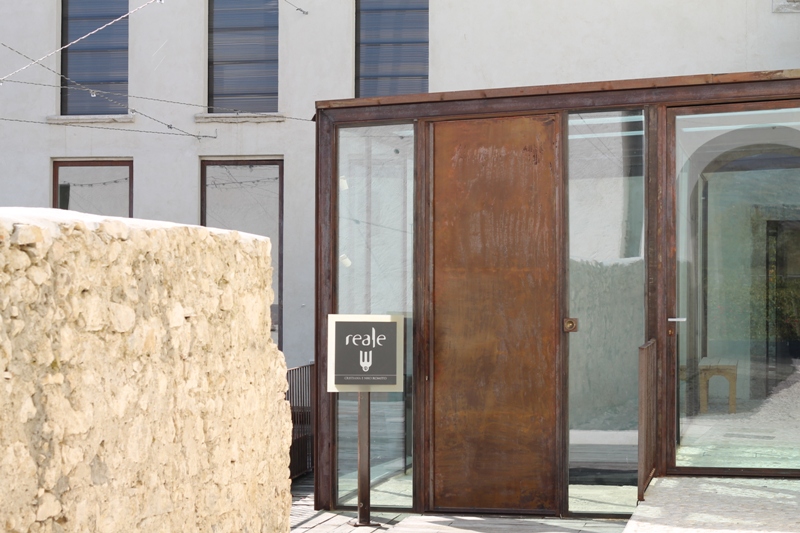Mauro Uliassi represents the tangible evidence that with perseverance and intelligence it is possible to reach any goal. A due introduction, never meant to diminish the undeniable creative capacities of the chef from the Marche region. Still, he has been able to put them in use of his outstanding human qualities.
In many years of attendance at the Banchina di Levante 6 (East Pier), we virtually never witnessed a wrong move or a choice outside the box. Then, when a hazardous decision made us turn up our nose (which honestly our memory hardly recalls), you can be sure that the critical note was received at exactly the same time in which the waiter had taken back to the kitchen the questioned plate.
Mauro Uliassi is a technical engineer of taste. He is methodical and precise, one that builds any preparation on the firm basis of his and his guests’ knowledge. He never pushes himself beyond his coherent knowledge, that today is of highest levels. Over the years, his abilities have been ceaselessly growing, from those long gone early 90s, when fried and mixed grill plates, namely sensational, would be served on our table.
Mauro studies continuously, he keeps himself up to date, he is never caught in the act. He has a total control of his little world in Senigallia, but with an eye he scans the landscape of the high-class restaurant industry on a worldwide level. And he is always able to keep up with the times.
It is an undeniable advantage, to have somebody like him in the kitchen. Because experience is a synonym for guarantee, for continuous discovery, for extreme pleasantness. Mauro spans with embarrassing talent from complex architectures that exalt the sea, to classic French inspired preparations with game, to creative interpretations of Marche’s regional traditions that enhance the gustatory memory of a curious teenager whom has grown up.
In our last visit, we appreciated the swerve towards fat-free preparations, that allow more room to vegetal elements and to a taste made of acidity and lightness. Voila: Mauro Uliassi, once again, hit on the nail. He metabolizes perfectly where the attainments of high-class culinary art and culinary modernity are today placed. Without any form of revolution or radicalism, he sits by the greats of this wonderful world, reasonably claiming his front seat. And the extraordinary thing (not to be taken for granted in the above-mentioned world), is that he does it while speaking at ease with either the most expert gourmet or the fledgling novice. His creations are meant for everybody, they embody that balance of flavor and intellect which many of his colleagues should envy him (and imitate).
Then, there is all the rest: the minimal and elegant restaurant, the dining room turning clockwise, the beautiful Catia (same Dna…), keeper of the final word. Without her, her brother Mauro probably couldn’t live as peacefully the daily existence of a great chef and a great man.
Waiting for the wine…
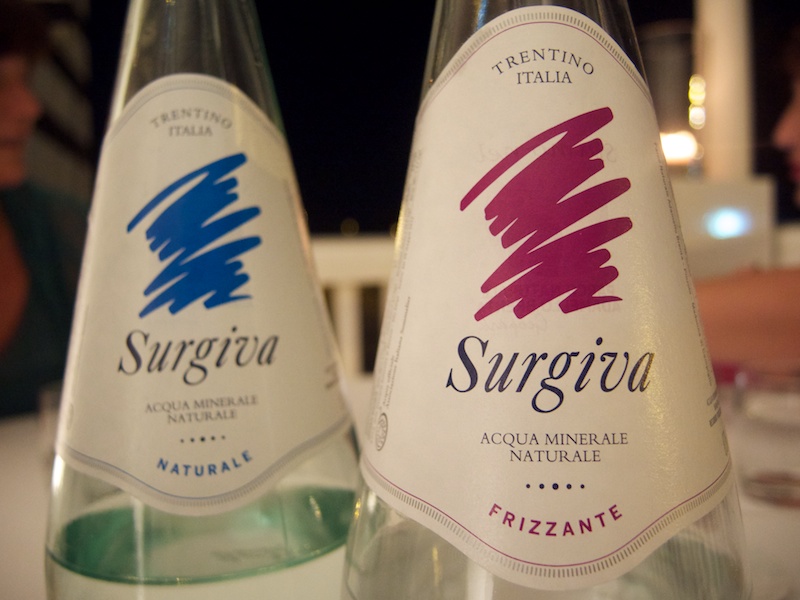
Loacker of foie gras and hazelnut praline, a classic by now.
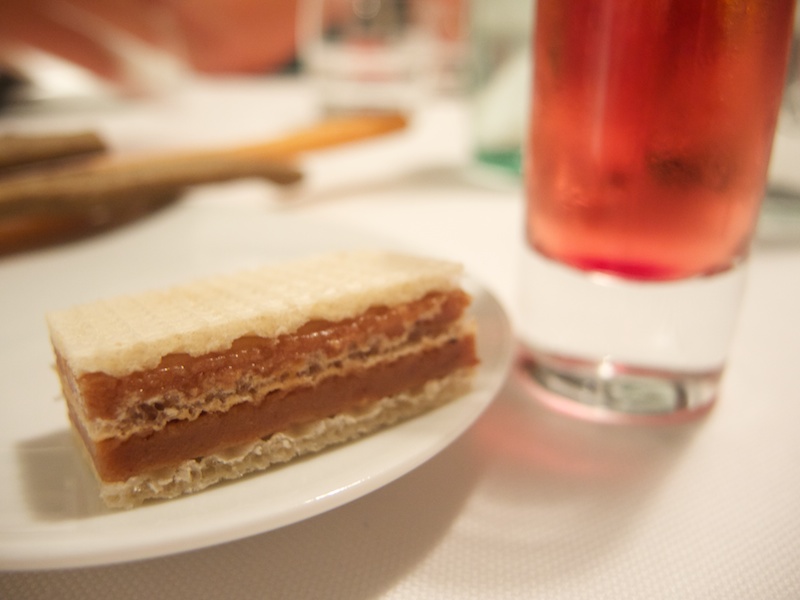
An Italian bubble, just to start.
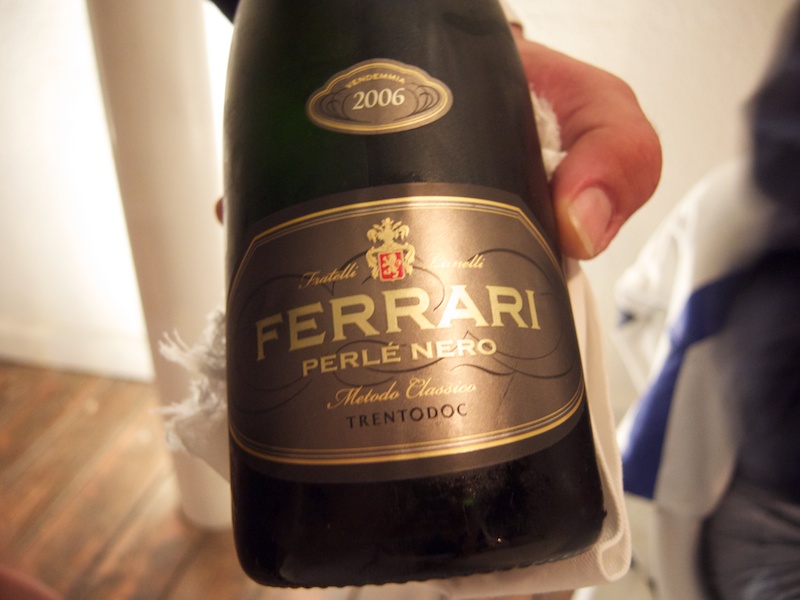
Crostino (toasted bread) with anchovies, butter and black truffle: an excellent beginning, between sapid and umami notes.
Cherry shrimps with plum
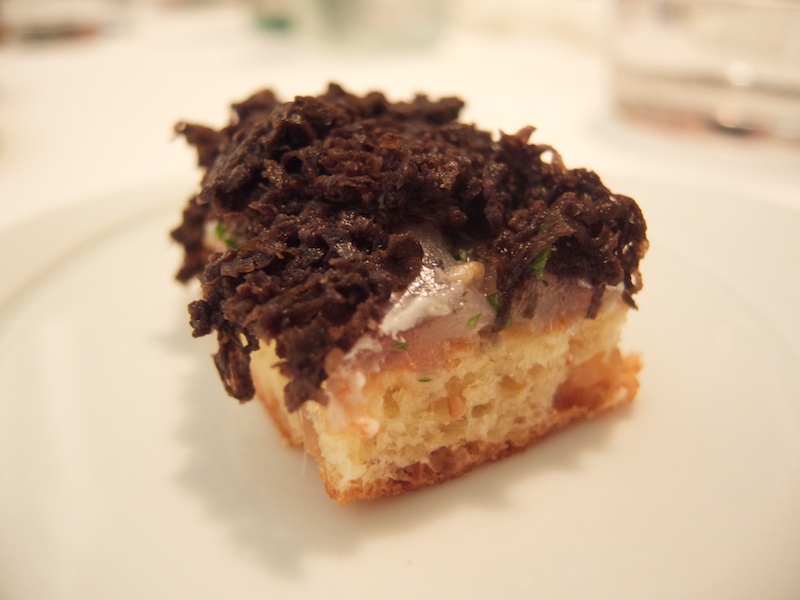
Cherry shrimps with plum béarnaise sauce and crust of cucumbers and capers: a dish of great impact and harmony of sweet, acid, vegetable and sapid. Nothing is missing.
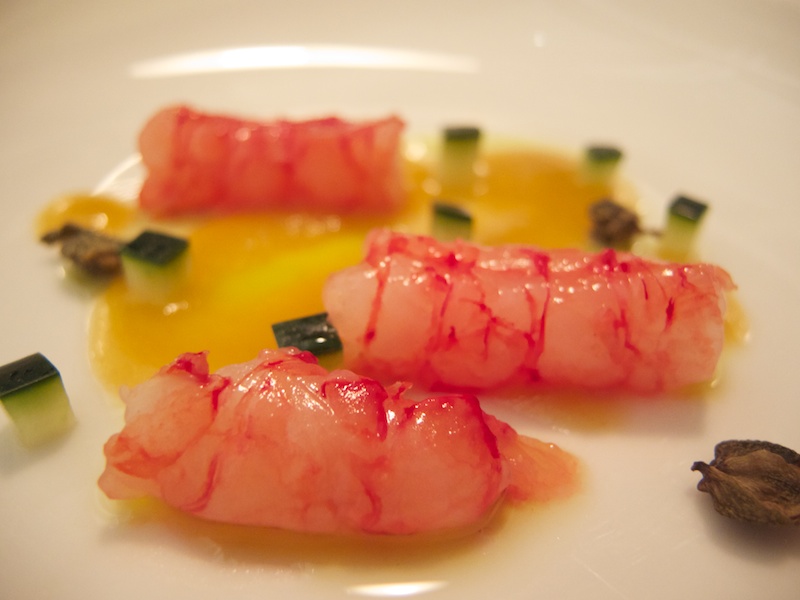
All-out first. One of Uliassi’s strong suits: the clam broth, shellfish, bitter almonds and herbs play in an iodized blend that leaves you agape.
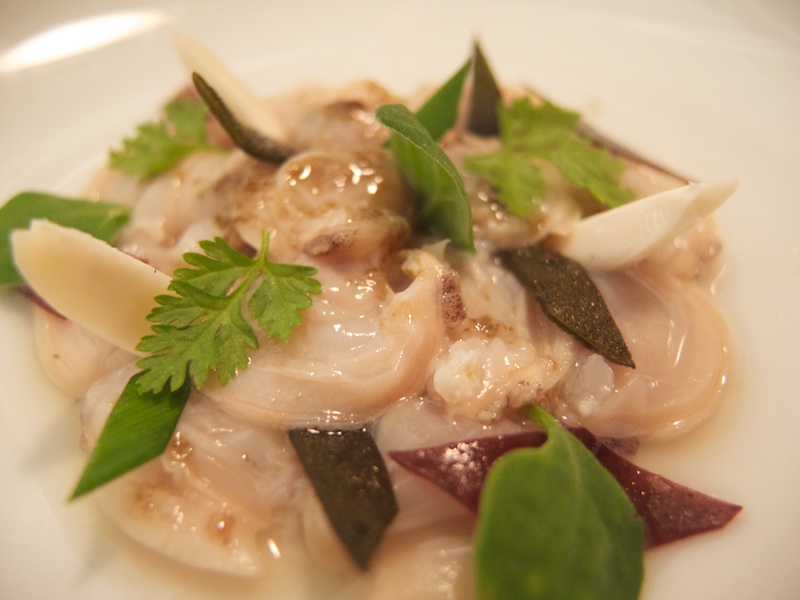
The bubbles were over…
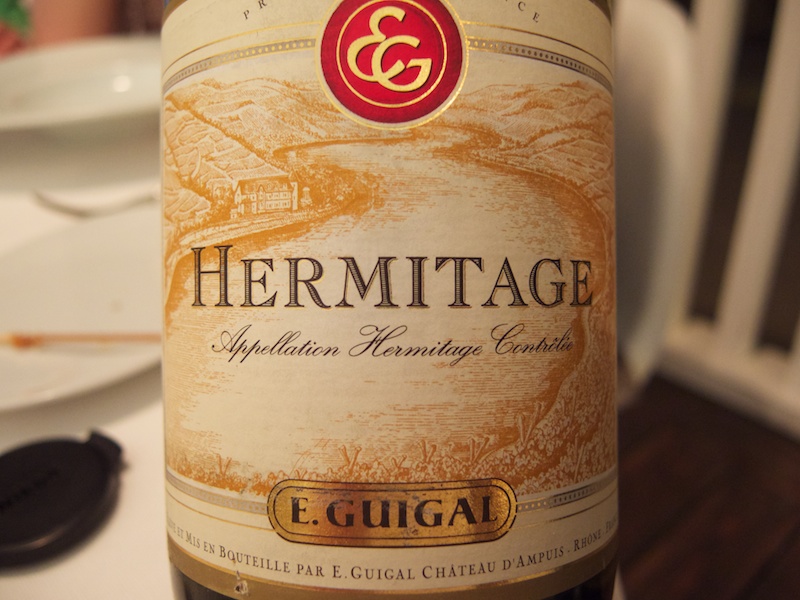
The ditch. The childhood memories of the chef, when ditches were the place for delicacy hunting. Frogs and snails, millimeter cooking, herbs dosed with the whiffletree. Heartbreaking.
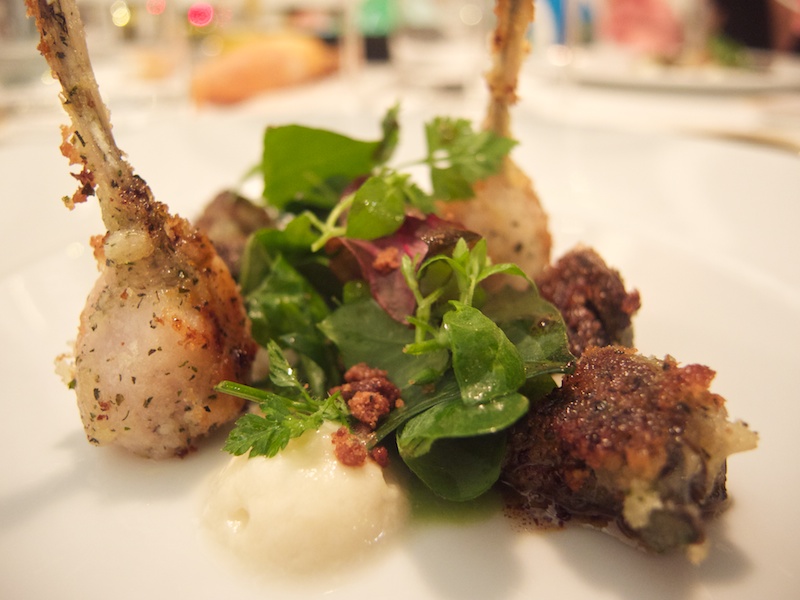
Crispy sole in saor, Langhirano ham, fresh cheese from Apulia. A dish inspired by Pellegrino Artusi, conceived and normally prepared with mullet, unavailable for our soirée. The sole alters slightly the dish’s delicate balance, but the final bitter note deserves a round of applause.
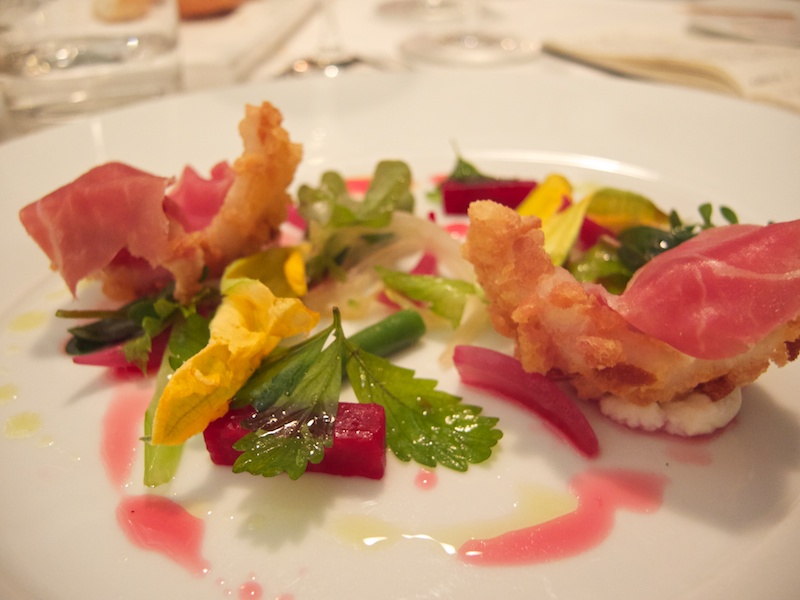
Chicken with salad. The dish stems from a “top” raw material and a perfect cooking.The aromatic quality and the acidity of the black garlic and squid ink Potacchio sauces, find a perfect balance.
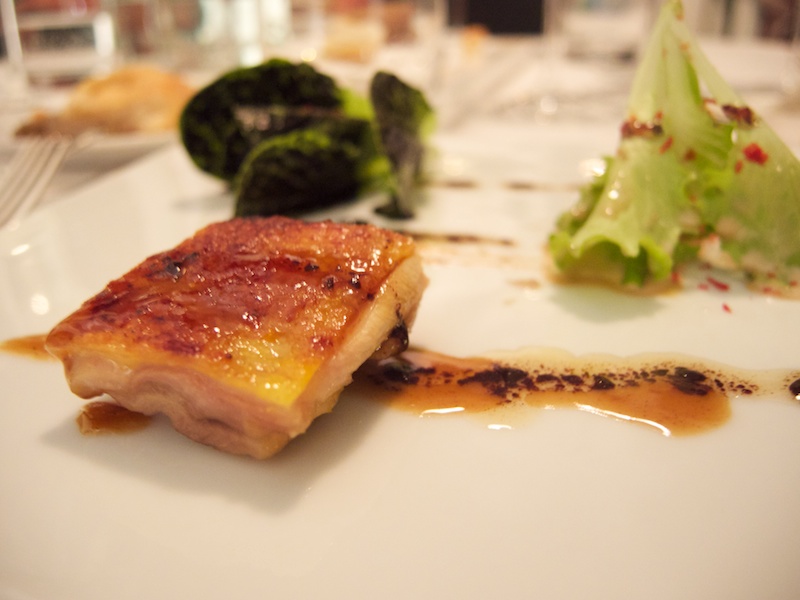
Young cuttlefish with its ink sac, sea urchin slush. When the slush melted, the dish became perfect.
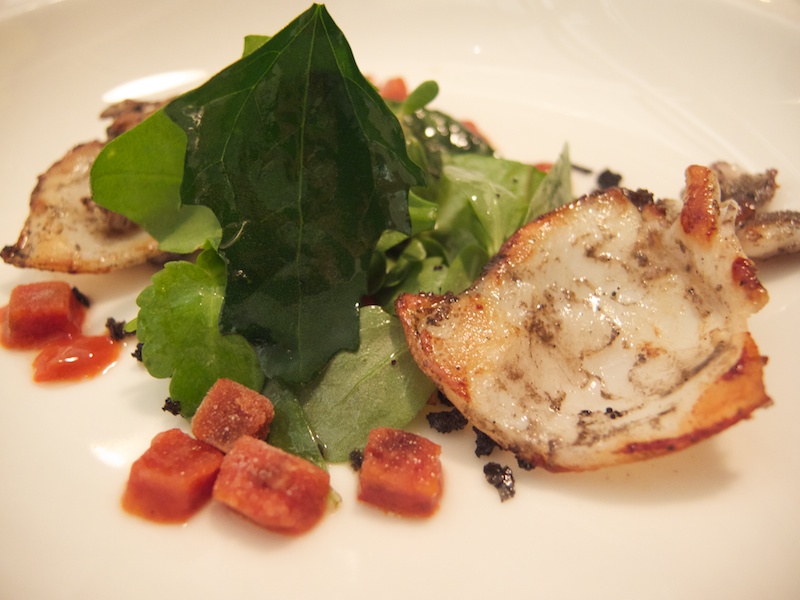
Greater amberjack “alla pizzaiola”. A wonderful dish of great balance.
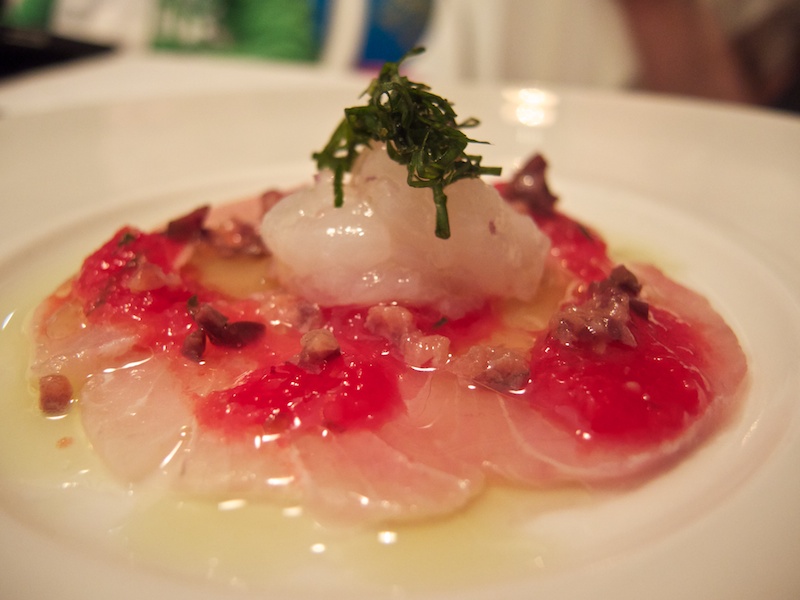
Just a glass of red wine for the road and there goes the meat. In the end, though, a certain feeling of delusion, because of a hardly memorable vintage.
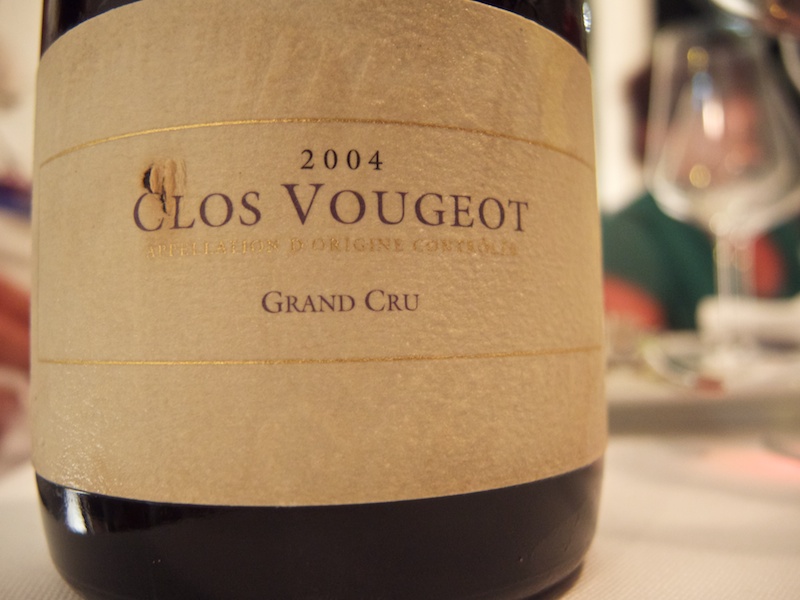
Fusilli, squid liver, chicory, sea urchins and minced shrimps. Possibly the dish of the evening: acidity and lightness, an intense while controlled aroma. Difficult to make it better.
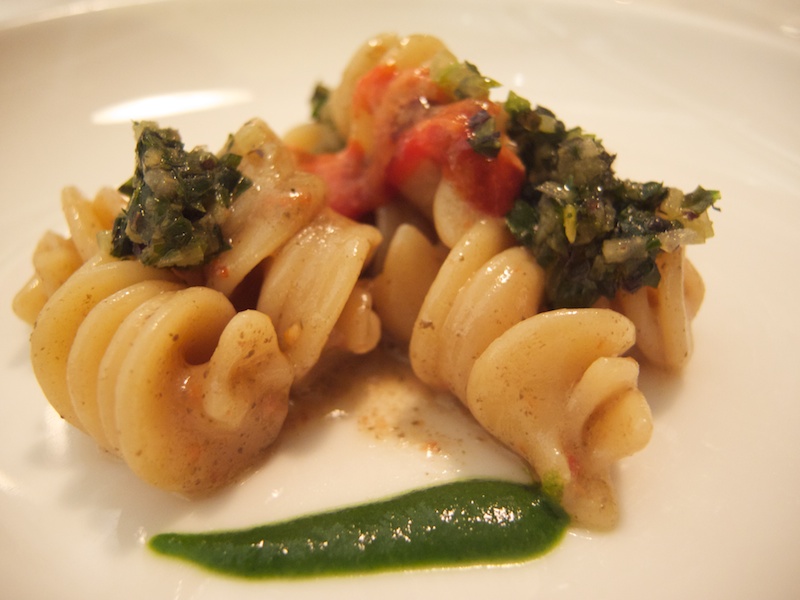
Tordi (birds), spring onions and sea snails. Sapid and determined. Too bad for the (excessive) spring onion that distracts the palate from the gustatory center of the dish.
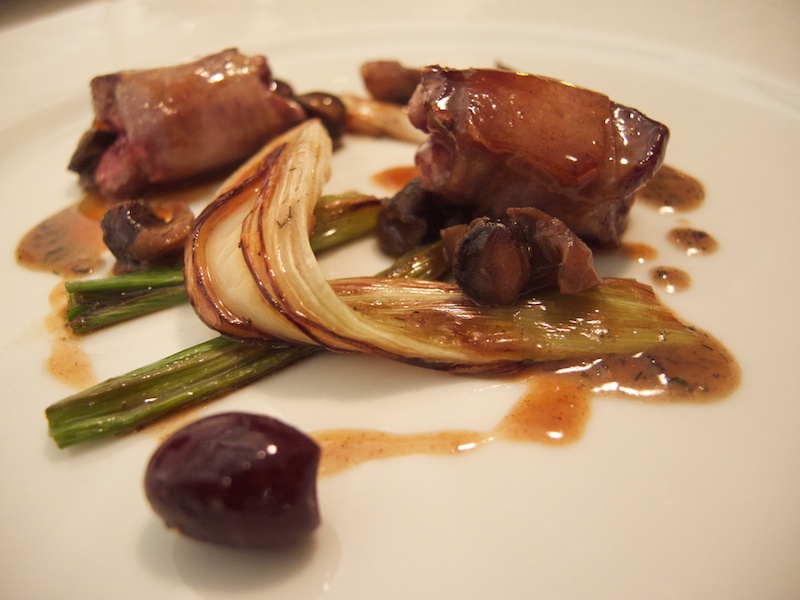
Watermelon and cardamom. In principle, the ending of the tasting menu.
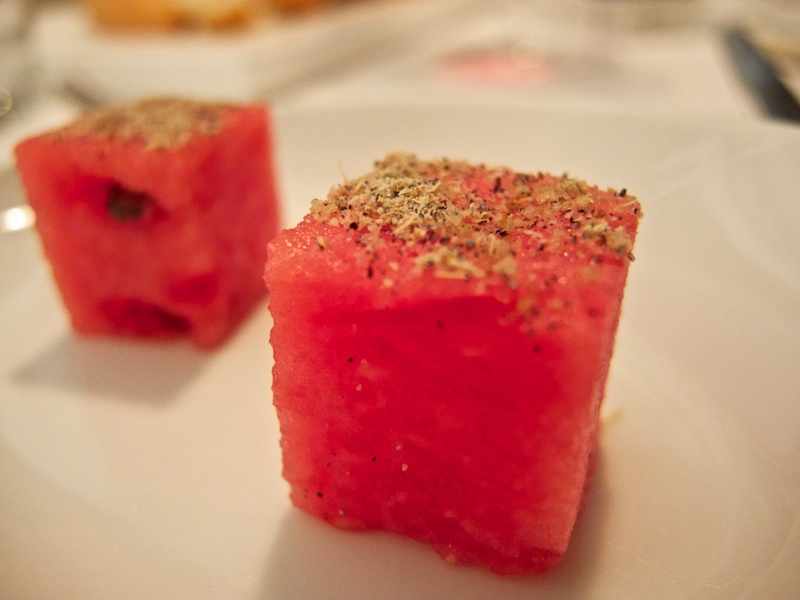
But here’s the surprise: Tagliatelle with raw and cooked hare. Now we are really knocked-out…
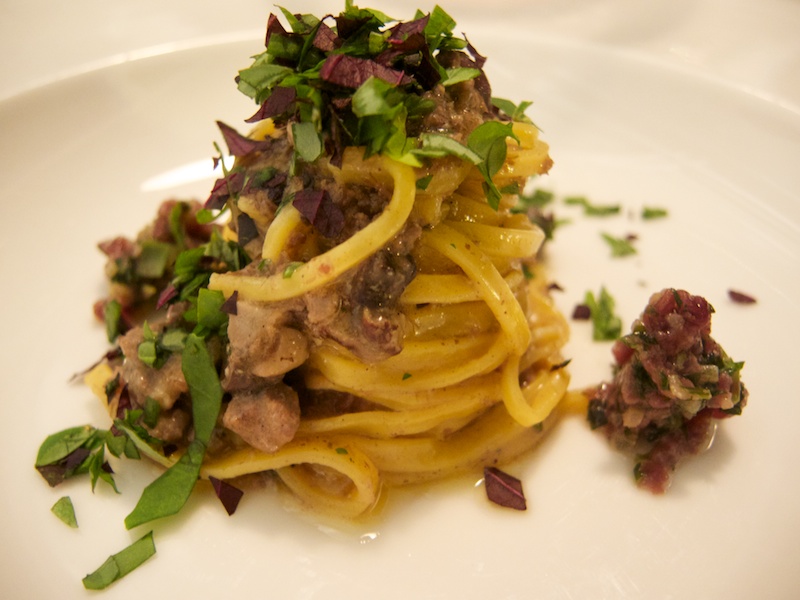
Ice cream of bucarello cheese and Giorgio Poeta’s honey. How to highlight in a perfect dessert two great local products (the cheese is by Trionfi Honorati in Jesi and the honey by Giorgio Poeta in Fabriano). That’s intelligence…
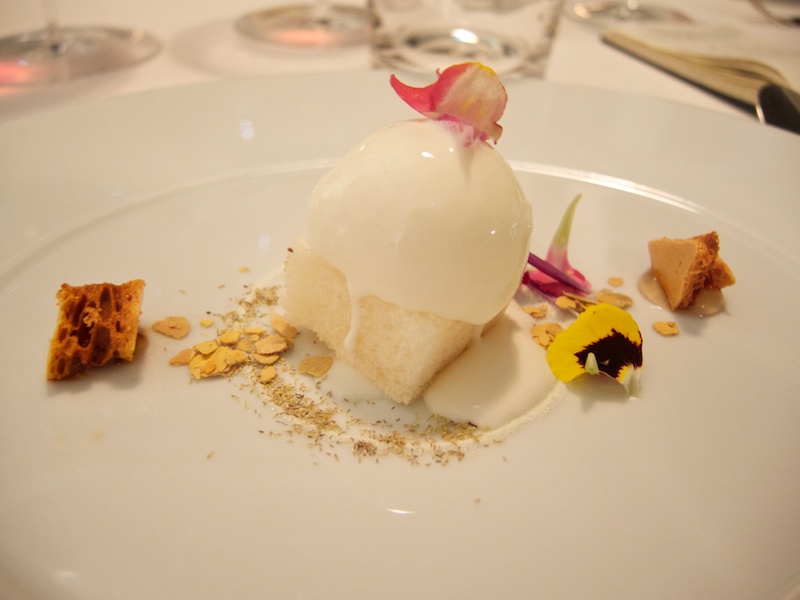
The scenographic Zuppa Inglese.
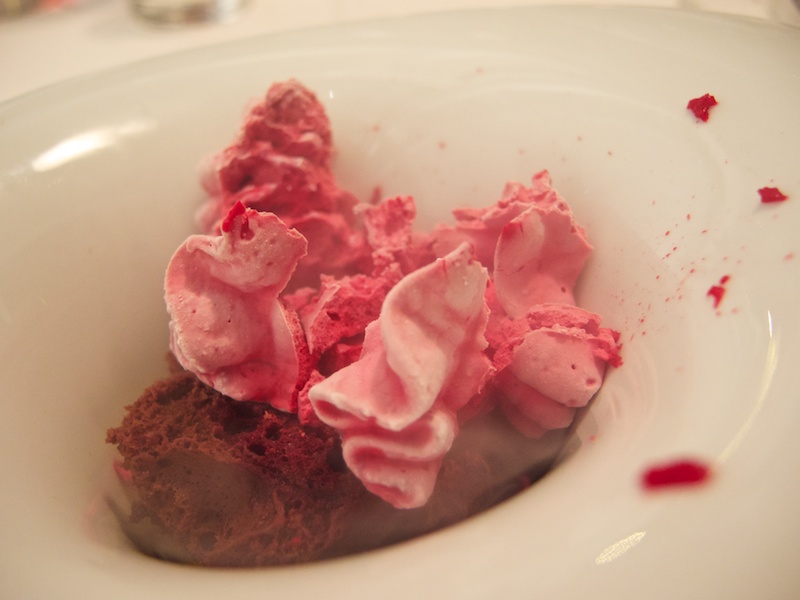
Petit fours, it certainly does not meet with the expectations.
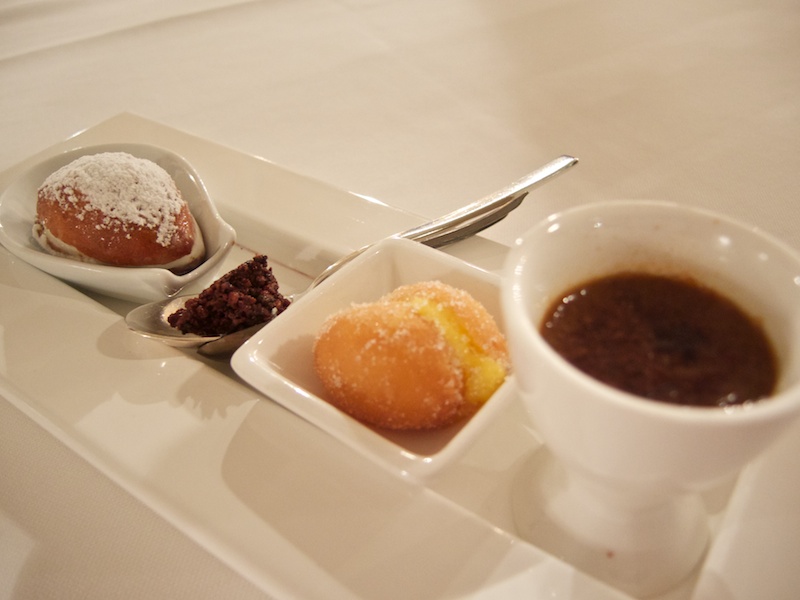
End of the evening…
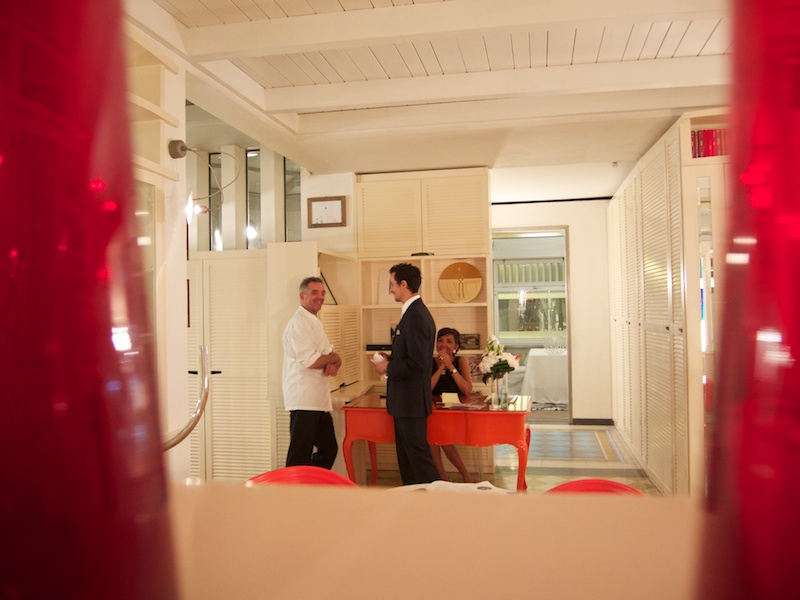
Mauro Uliassi è la dimostrazione tangibile che con la tenacia e l’intelligenza si può raggiungere qualunque risultato. Una premessa obbligata, che non vuole affatto sminuire le indubbie capacità creative dello chef marchigiano, che ha saputo però metterle al servizio delle sue notevoli qualità umane.
In tanti anni di frequentazioni alla Banchina di Levante 6 quasi mai abbiamo assistito ad un colpo sbagliato o a una scelta fuori dagli schemi, e quando una decisione azzardata ci ha fatto storcere il naso (e sinceramente la nostra memoria stenta a ricordarla) state pur certi che l’appunto critico è stato recepito nel tempo esatto con cui il cameriere ha riportato in cucina il piatto messo in discussione.
Mauro Uliassi è un ingegnere della tecnica del gusto, metodico e preciso, che costruisce ogni preparazione sulle solide basi della conoscenza sua e di quella dei suoi avventori. Non si spinge mai più in là del suo coerente sapere, che ad oggi è di un livello altissimo. Negli anni le sue capacità sono cresciute a dismisura, da quei lontani primi anni ’90 quando sulla nostra tavola arrivavano fritti e grigliate miste, tra l’altro strepitose.
Mauro studia di continuo, si aggiorna, non si fa mai beccare in castagna. Ha un controllo assoluto del suo piccolo mondo in quel di Senigallia, ma con l’occhio osserva attentamente il panorama dell’alta ristorazione a livello mondiale. E riesce sempre a stare al passo con i tempi.
Un indubbio vantaggio avere in cucina una persona del genere, perché l’esperienza è sinonimo di garanzia, di continua scoperta, di estrema piacevolezza. Mauro passa con una facilità imbarazzante da complesse architetture che esaltano il mare, a classiche preparazioni d’ispirazione francese con la cacciagione, a creative interpretazioni della tradizione marchigiana che esaltano la memoria gustativa di un adolescente curioso che è diventato grande.
Nella nostra ultima visita abbiamo apprezzato la decisa sterzata verso preparazioni prive di grassi, che danno maggiore spazio a elementi vegetali e a un gusto fatto di acidità e leggerezza. Ecco: Mauro Uliassi, anche questa volta, ha fatto centro, metabolizzando alla perfezione dove l’alta cucina e la modernità culinaria si collocano oggi. Senza rivoluzioni o estremismi si siede accanto ai grandi di questo meraviglioso mondo, pretendendo a ragione il suo posto in prima fila. E la cosa straordinaria (non sempre ravvisabile nel suddetto mondo) è che fa tutto ciò colloquiando amabilmente con il più esperto gourmet ma anche con il neofita alle prime armi. I suoi piatti parlano a chiunque, sono la sintesi di un equilibrio gustativo e intellettivo che molti suoi colleghi gli dovrebbero invidiare (e dovrebbero imitare).
Poi c’è tutto il resto, il ristorante minimale ed elegante, la sala che gira come un orologio, la bella Catia (il Dna è lo stesso …) che tutto verifica e controlla, senza la quale probabilmente il fratello Mauro non potrebbe vivere serenamente la sua quotidiana esistenza da grande chef e da grande uomo.
In attesa del vino…

Loacker di foie gras e pralina di nocciole, oramai un classico.

Una bolla italica tanto per iniziare.

Crostino di alici, burro e tartufo nero: splendido inizio, tra note sapide e umami.

Gambero rosso con salsa bearnaise alle prugne e corteccia di cetriolo e capperi: piatto di grande impatto ed equilibrio tra il dolce, l’acido, il vegetale e il sapido. Non manca nulla.

Prima secca. Uno dei cavalli di battaglia di Uliassi: il brodo di vongole, i molluschi, le mandorle amare e le erbe giocano in un concentrato iodato da rimanere a bocca aperta.

Le bollicine erano finite…

Il fosso. Il ricordo d’infanzia dello chef, quando i fossi erano luoghi di caccia di bontà. Rane e lumache, cotture millimetriche, erbe dosate col bilancino. Da lacrime.

Sogliola croccante in saor, prosciutto di Langhirano, formaggio fresco pugliese. Un piatto d’ispirazione artusiana, pensato e normalmente eseguito con la triglia, non disponibile nella nostra serata. La sogliola toglie qualcosa all’equilibrio del piatto data la sua delicatezza, ma la nota amara nel finale è da applausi.

Pollo con insalata. Il piatto nasce da una materia prima “top” e da una cottura straordinaria. L’equilibrio è retto tra l’aromaticità e l’acidità delle salse di Potacchio, all’aglio nero e al nero di seppia.

Seppiolina giovane sporca, granita di ricci di mare. Quando la granita si è sciolta il piatto è diventato perfetto.

Ricciola alla pizzaiola. Splendido piatto, di grande equilibrio.

Giusto un rosso per proseguire, arrivano le carni. Ma alla fine discreta delusione, per colpa di un’annata non memorabile.

Fusilli, fegato di seppie, cicoria, ricci e trito di gamberi. Forse il piatto della serata: acidità e leggerezza, aromaticità intensa ma controllata. Difficile fare meglio di così.

Tordi, cipollotti e raguse. Sapido e deciso, peccato per il cipollotto (eccessivo) che distrae il palato dal centro gustativo del piatto.

Anguria e cardamomo. In teoria la chiusura del menù degustazione.

Ma ecco la sorpresa: Tagliatelle di lepre cotta e cruda. Ora sì che siamo ko…

Gelato di formaggio bucarello e miele di Giorgio Poeta. Come esaltare in un dessert perfetto due grandi prodotti del territorio (il formaggio è di Trionfi Honorati di Jesi e il miele di Giorgio Poeta di Fabriano). Ecco l’intelligenza…

La scenografica zuppa inglese.

Petit four, decisamente non all’altezza delle aspettative.

Fine serata…

The way to perfection.
Conception, execution, result: gestures repeated obsessively in the search for constant improvement. Day after day. A whole life long.
Jiro Ono is a man of 88, still at the vanguard in his tiny restaurant in the subway station in Ginza.
Jiro Onu is a shokunin. It is difficult to translate this word, so far from our culture. The term “artisan” isn’t fair indeed: shokunin means a lot more.
It definitely implies technical skills, but also a knowledge and a social approach. The shokunin has the social duty to work at his best for the general well-being of the population. A duty that is spiritual as well as material. That’s something huge, but it is essential to have it clear in mind before entering this place.
”You must fall in love with your work”, said Jiro in the famous documentary by David Gelb, Jiro Dreams of Sushi.
How lucky is the man who can find the passion and the power in his work, falling in love with what he’s meant to do daily for the community! There, the union between life and work becomes a vocation.
The whole life of this man was nothing but a path to a kind perfection that is unreachable: you don’t know the peak, but you constantly have to aim at it.
«I will continue to climb, trying to reach the peak, although nobody knows which one it is». (Jiro Ono)
But Sukiyabashi Jiro is not simply the container of the story of a great man. There are many stories to be told here, and they intertwine as the lives of the human beings. There is the story of Yoshikazu, Jiro San’s eldest son, day after day at his father’s side. He carries on his shoulders the burden of the legacy which will probably label him as an eternal second best. He’s the one who goes to the market every day to choose the fish. Only the best, for Jiro Ono. Even 40 tunas might be opened before finding the one that deserves to be served by Jiro San.
There is the story of Takashi, the younger son. He opened a restaurant in Roppongi Hills, that is the exact mirror-copy of his father’s restaurant (Takashi is left-handed). An escape that could transcend into release and rebirth.
Or the story of the many trainees pending for a sign of approval from the Master. One has the assignment to wring out the towels. Another, for months, does nothing but preparing sweet omelets. Another one’s still rubbing down the octopuses (for fifty minutes at least, to soften them).
There are no exceptions or gifts: everything here is hard-earned on the field.
Nowadays parents tell their children: “If it doesn’t work, just come home”. When parents tell such nonsense, children are destined to fail in life. (Jiro Ono)
Two virtues characterize the Japanese culture: the honor and the research of pureness.
Honor is an essential part of the work, in the love you feel for it and in the constant search for improvements.
Pureness, on the other hand, is to be found in simplicity.
Nothing more simple than the combination of rice and fish in a harmonic vortex that leads to the fusion of this two elements.
Rice: most people tend to overcook it. In Jiro’s you can taste the vinegar and it is served at blood heat. It is cooked on a very high pressure, which makes it soft and vaporous, while keeping the integrity of each single grain. It is a revelation, an extraordinary rice.
Fish: all plates are excellent, at least. The daily supply at the market in Tokyo is obsessive.
Harmony: the perfect union between the two elements is conveyed in the taste, unique and thrilling as it is.
The wasabi, modulated in quantity according to the piece. An initial blow leaves room to the taste of this incredible root, that in Japan touches absolute quality peaks.
A brushstroke of soy sauce. Then right in the mouth, in a few seconds, because perfection is fleeting.
The menu – 19 fixed courses – mounts like a wave, in a crescendo of flavors.
Only sushi prepared by the Master in front of your eyes. 30 minutes for the best spent 240 euro of your life.
A composition that draws closer earth and sky, ceaseless neurosensory shocks which will hardly be forgotten.
Who knows if we will ever have the chance again to enjoy the sushi prepared by this monument of the world gastronomy. Who knows if we would still find him there, refining his rice, his fish, his sushi. Building his destiny from himself on, day after day.
After day, after day…
Practical notes: the reservation can be made by the hotel concierge, only the first day of the month preceding the visit (e.g. 1st of September for October).
The restaurant is by the Ginza subway station. Look for the sign of the Birdland restaurant, with the English sign, and gain access to the aisle. Jiro is right in front.
The menu is fixed, but when it is over you can ask for an encore of the pieces you liked the most.
Only cash is accepted, so don’t forget to stuff yourself before entering the restaurant.
Entrance
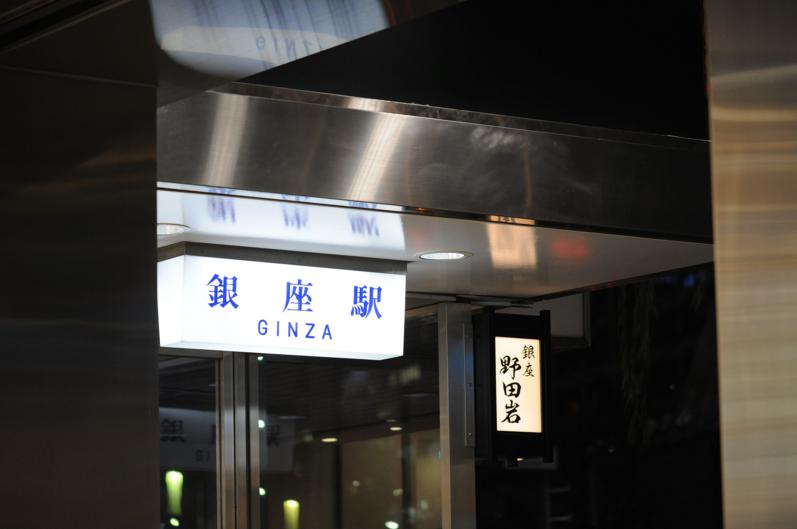
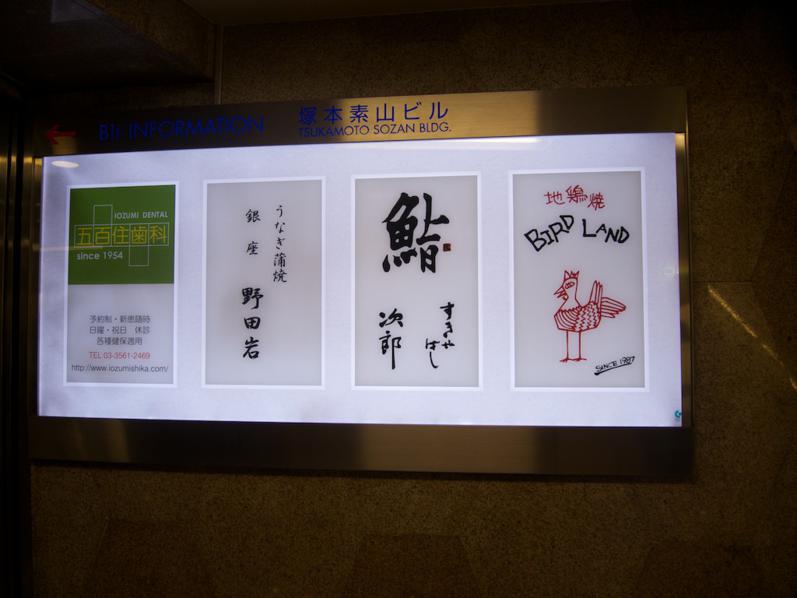
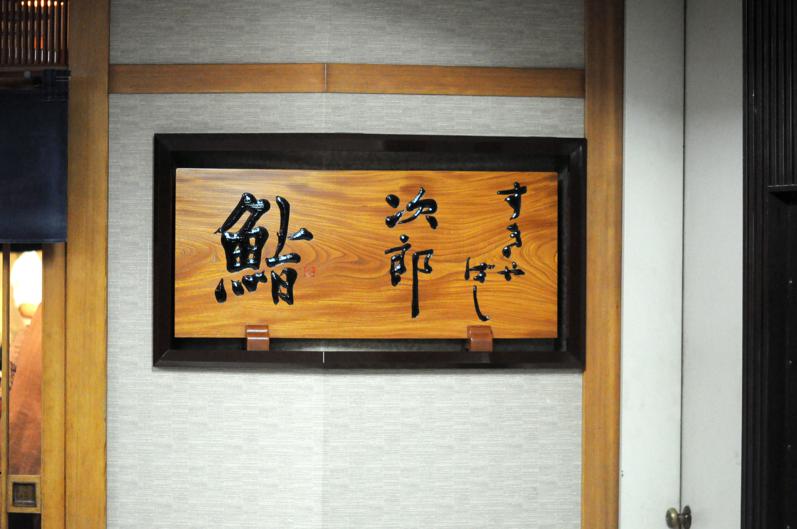
Karei: European flounder
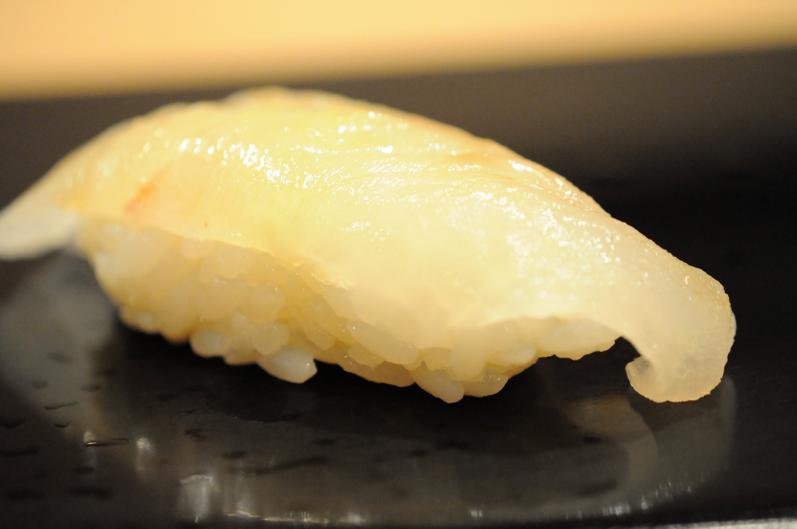
Sumi-ika: squid
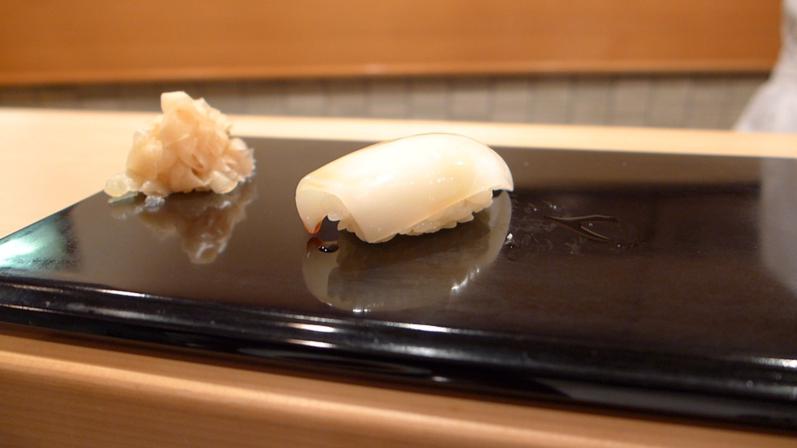
Shima-aji: striped jack (caranx vinctus)
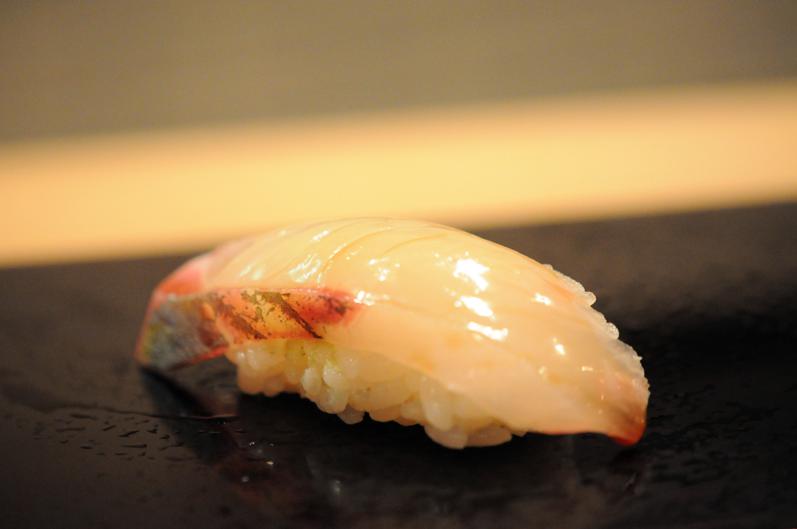
Akami: tuna
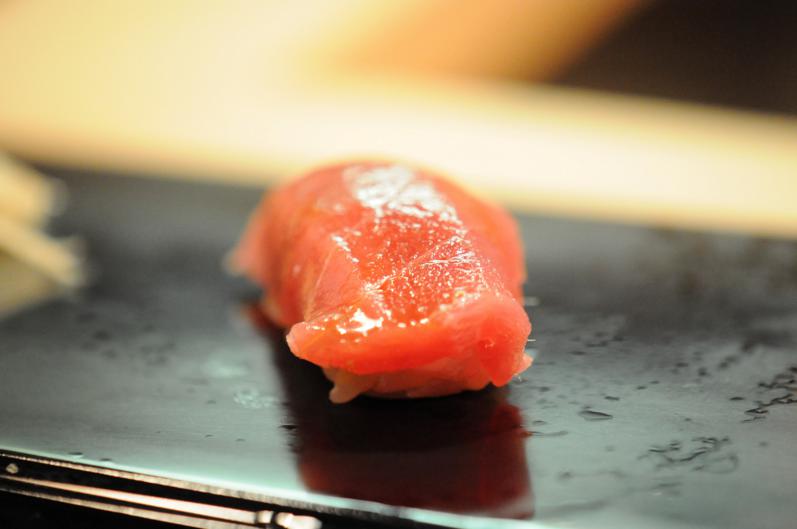
Chu-toro: medium fatty tuna
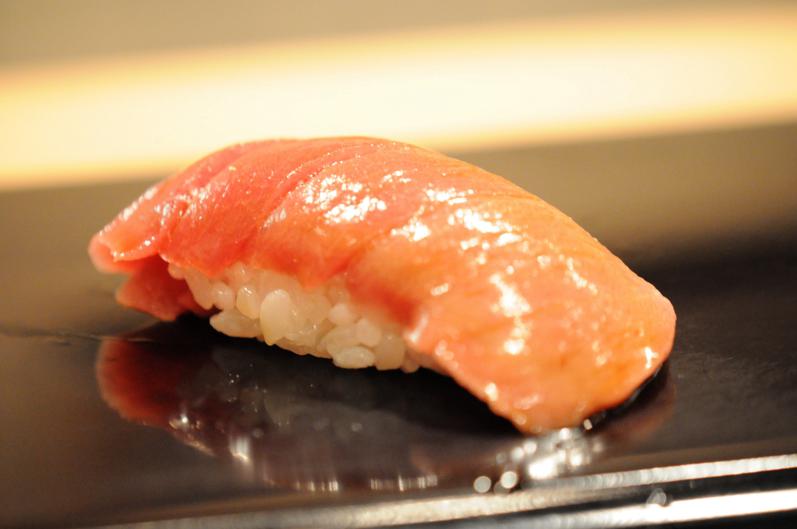
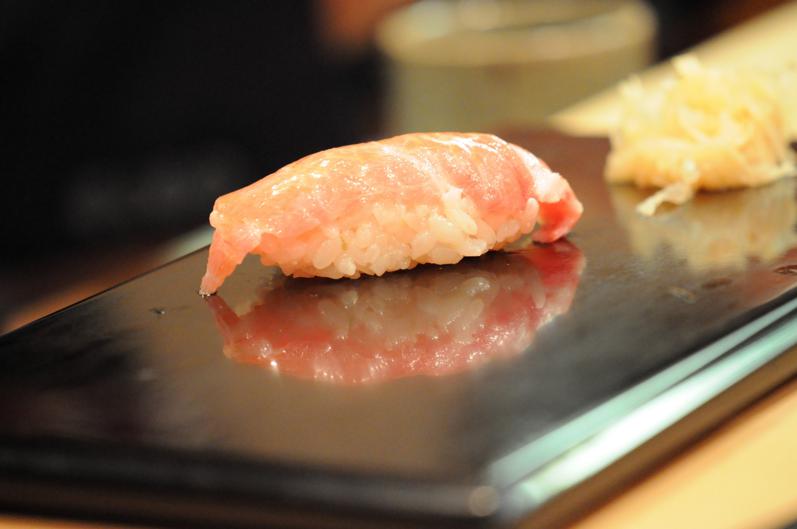
Kohada: gizzard shad
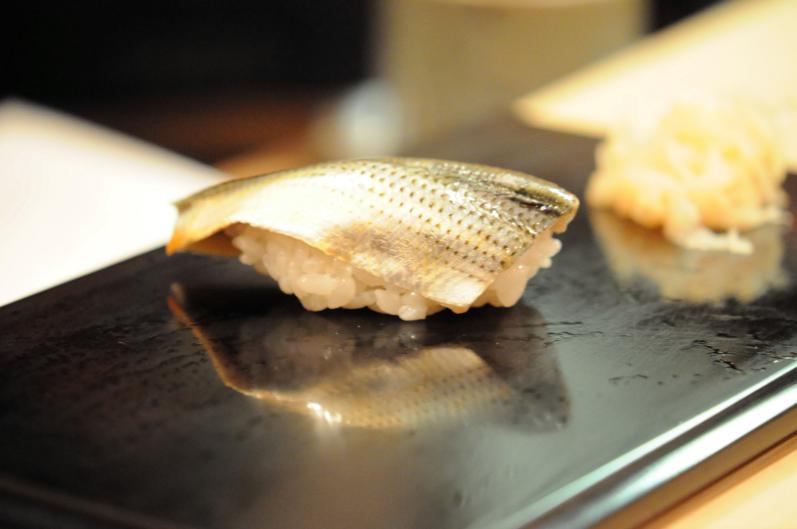
Mushi-awabi: steamed Abalone
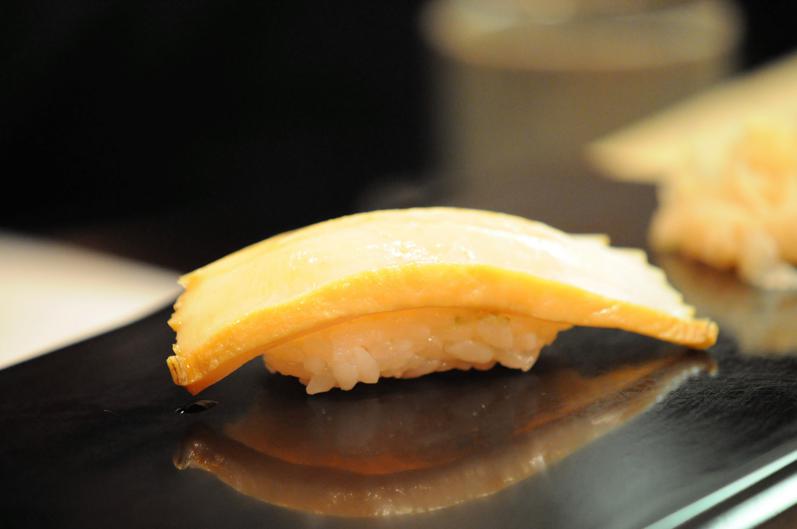
Aji: Jack mackerel
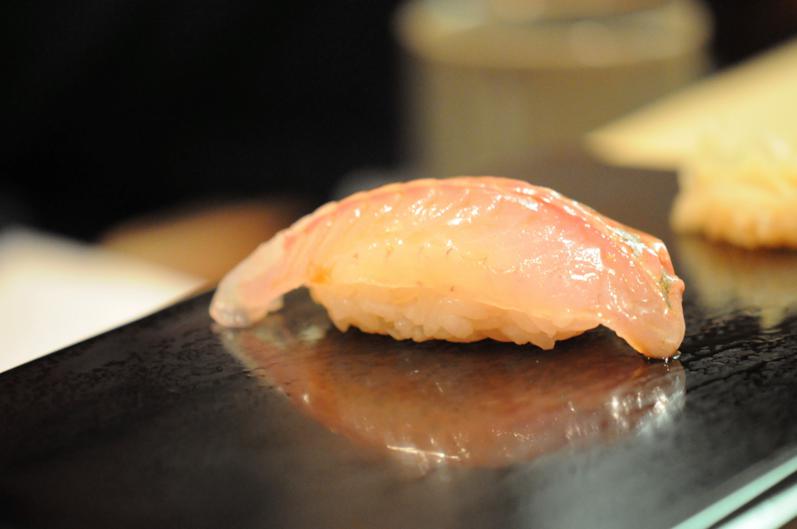
Kurumaebi: boiled prawn
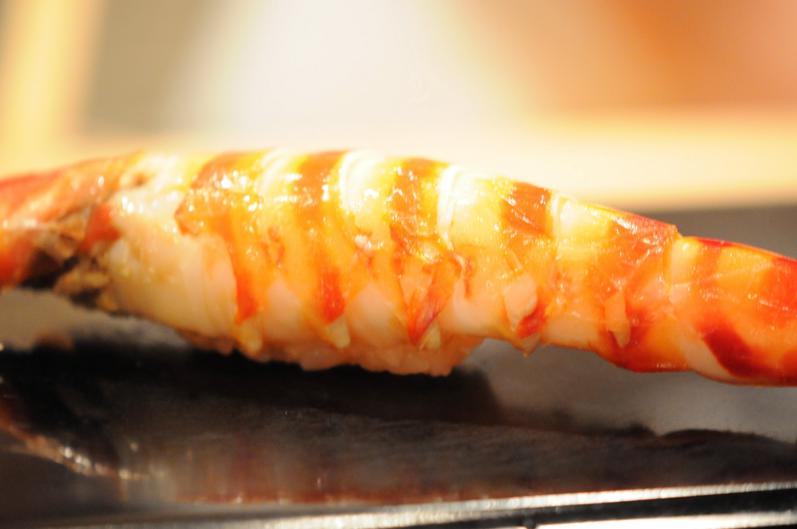
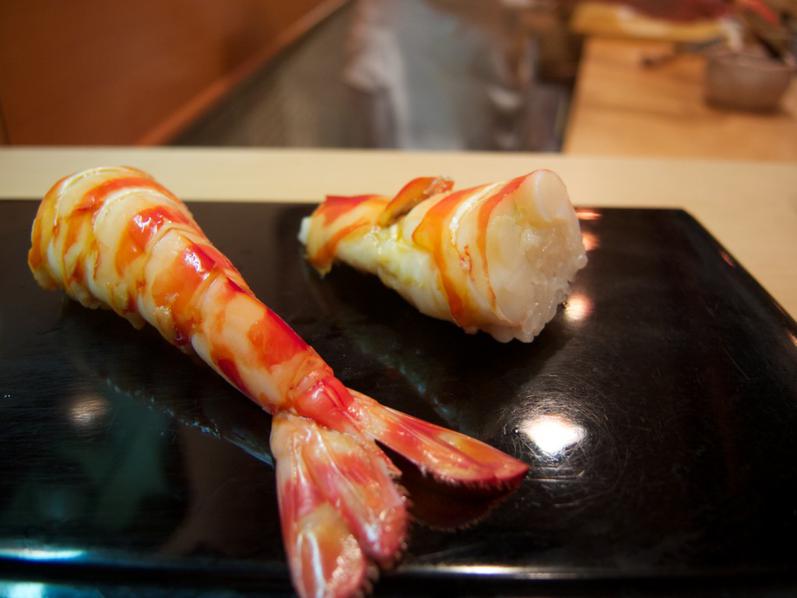
Katsuo: little tuna. Lightly smoked, the peak of the entire meal. Taste and texture beyond words.
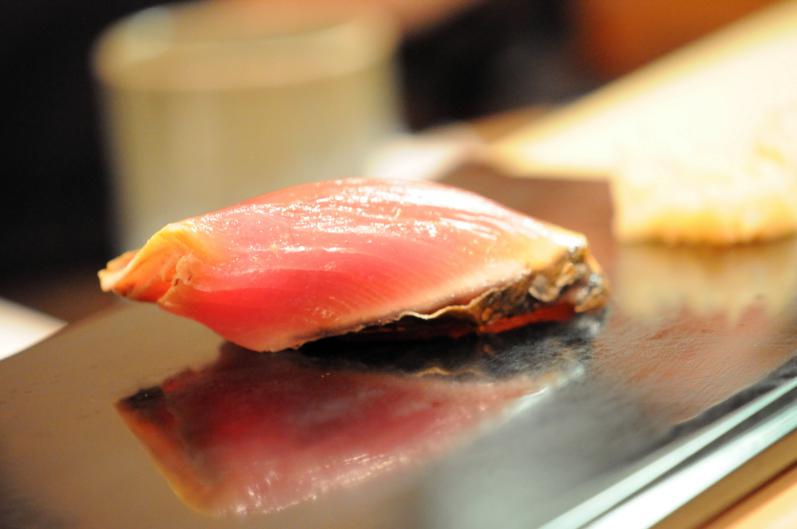
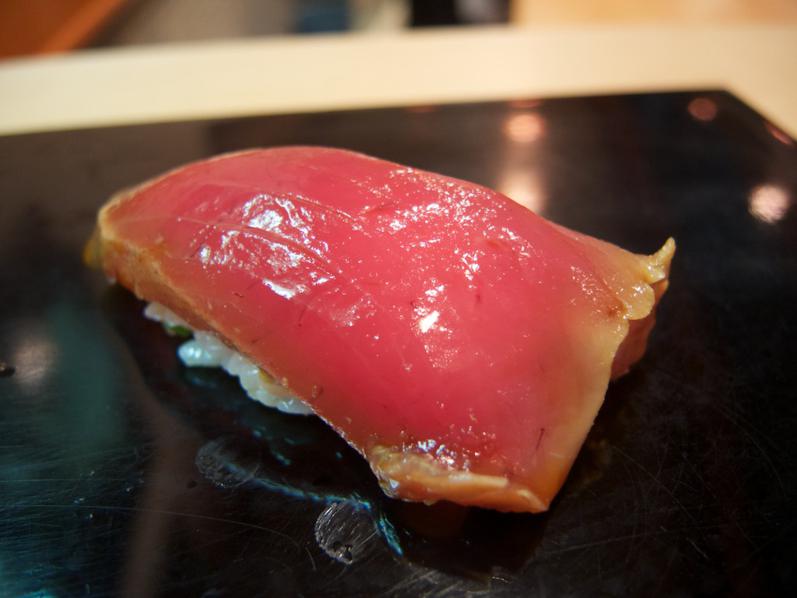
Shako: Squilla mantis shrimps
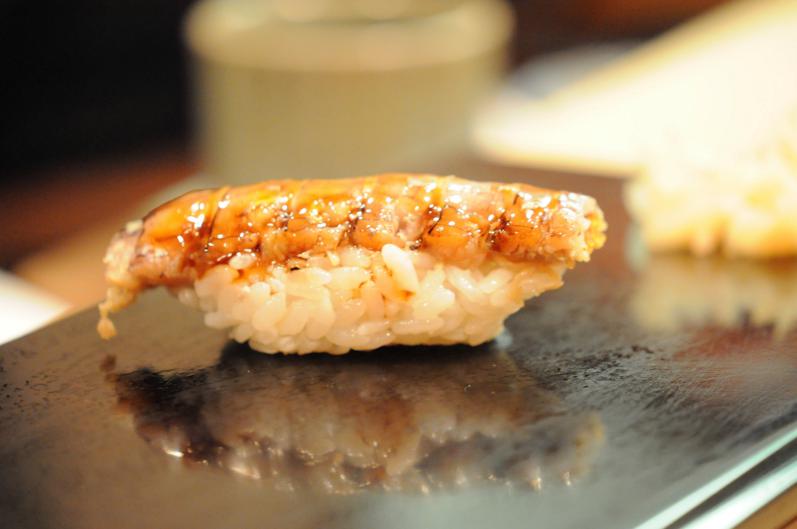
Iwashi: Sardina. Another striking blow of which in fact we asked for an encore.
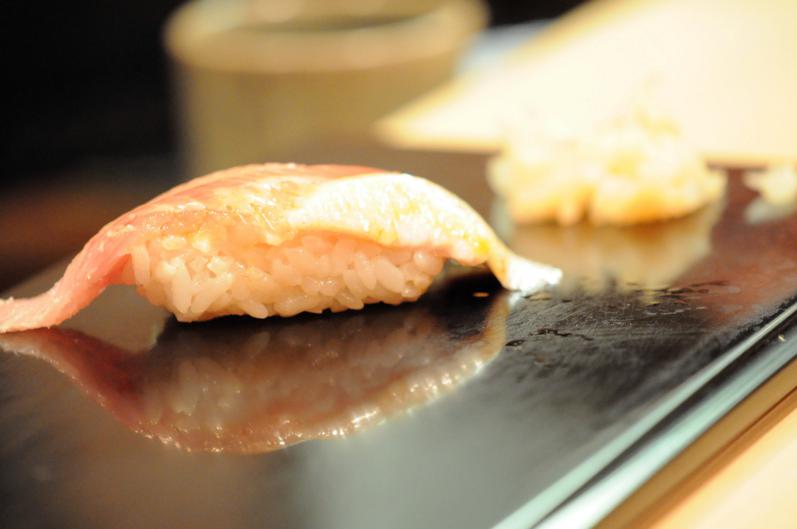
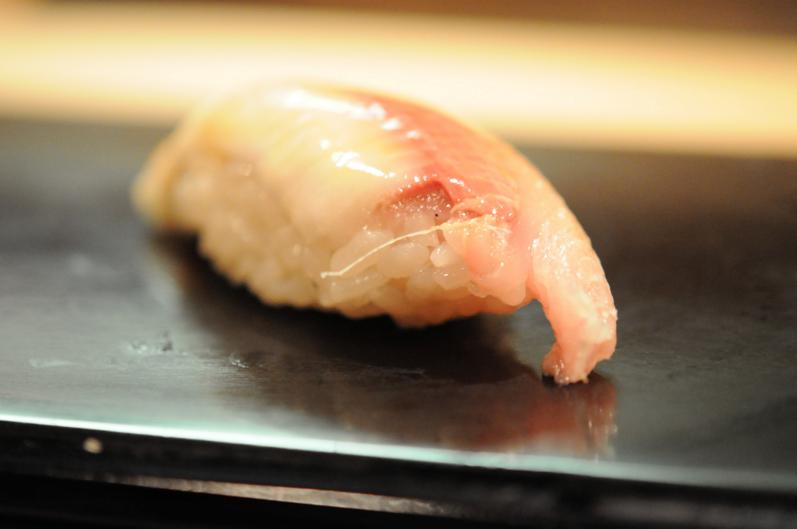
Akagai: ark shell
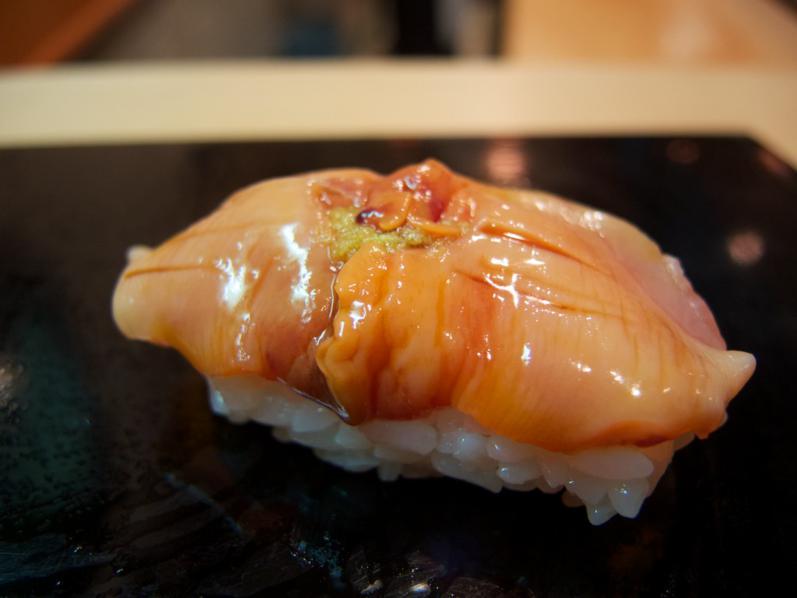
Uni: sea urchin
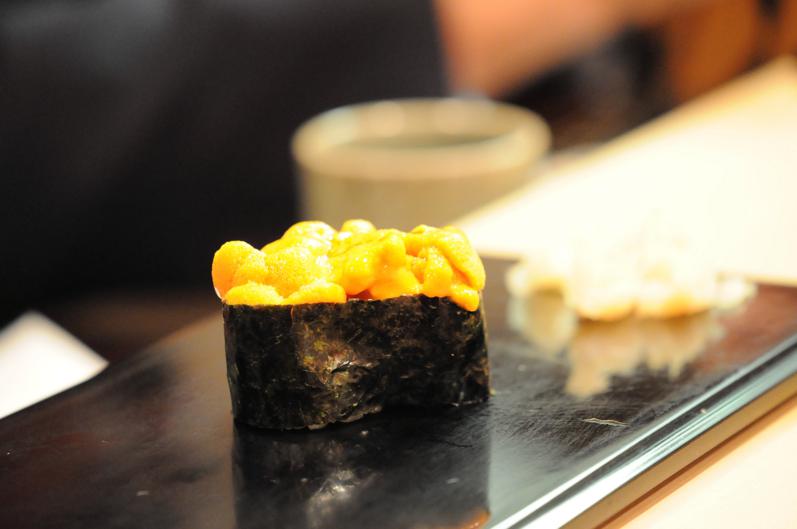
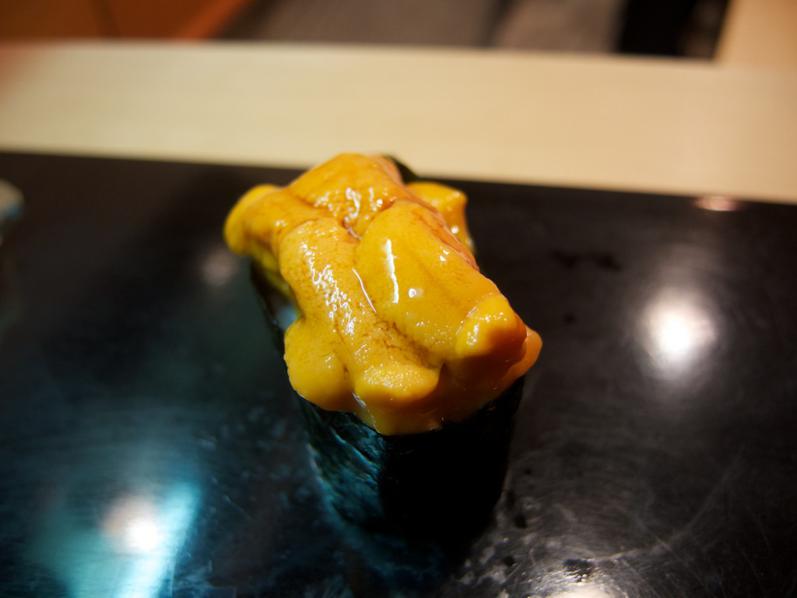
Kobashira: scallop
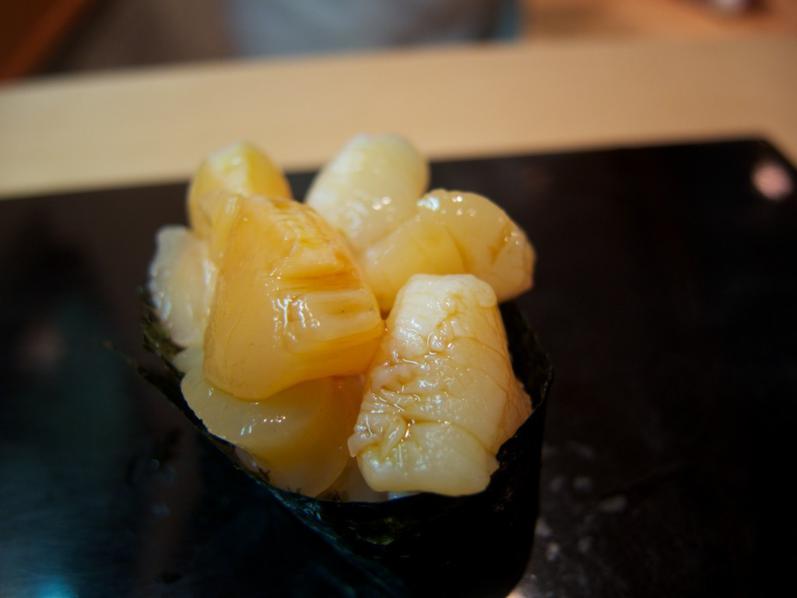
Ikura: salmon eggs
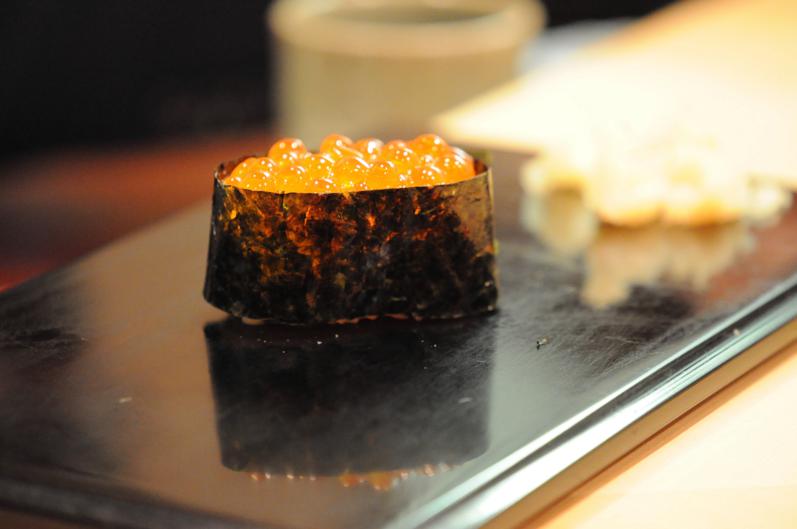
Anago: eel
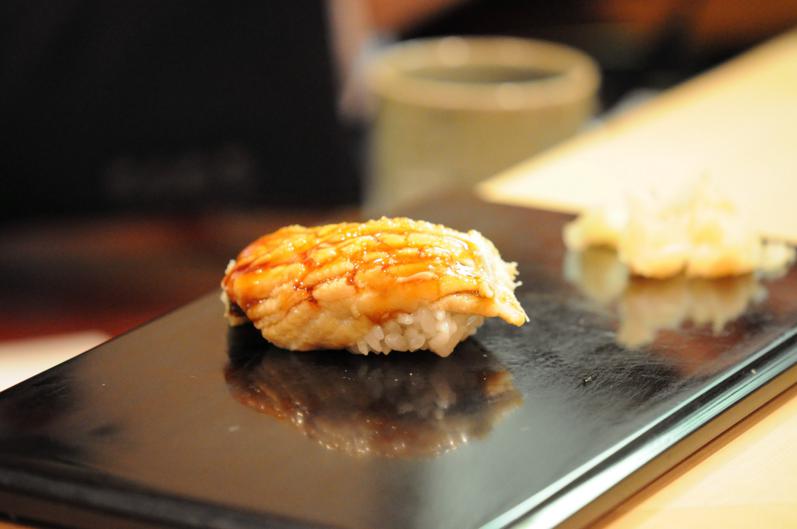
Tamago: sweet egg omelet. The texture of this omelet is unique. Just an omelet? No jokes please…
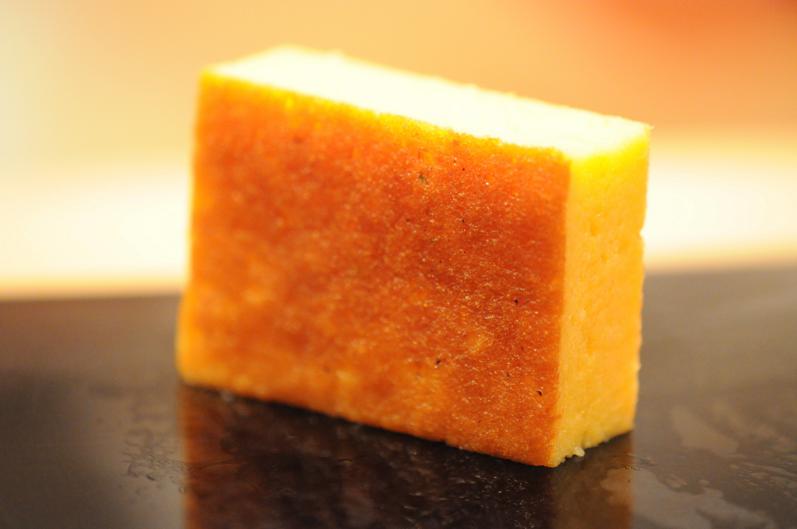
Musk Melon: the flavor intensity of these highly expensive Japanese melons (at the market they are sold at about 100 euro per piece) is impossible to describe
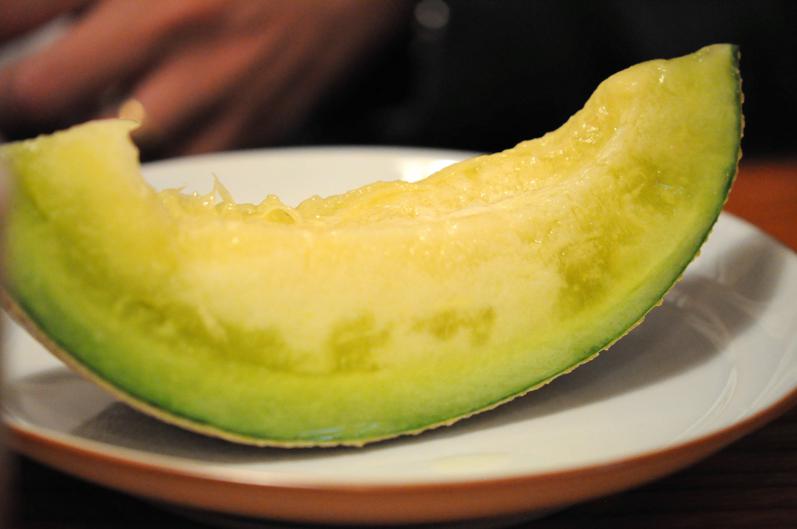
Simple mise en place
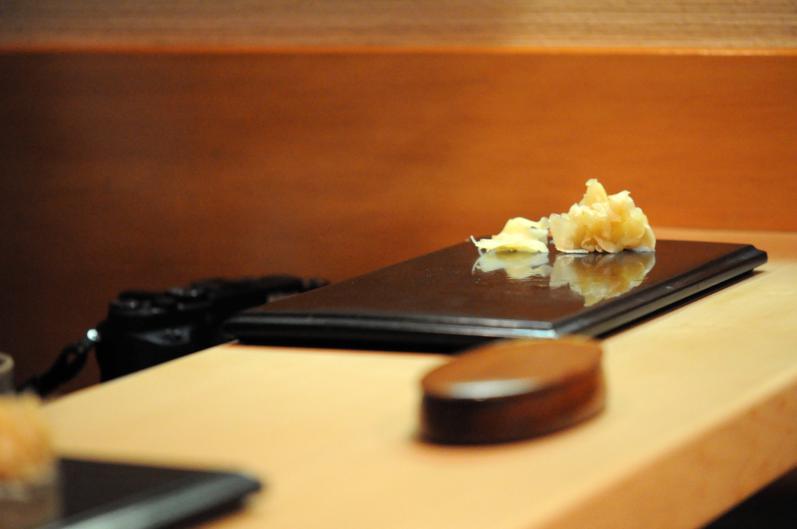
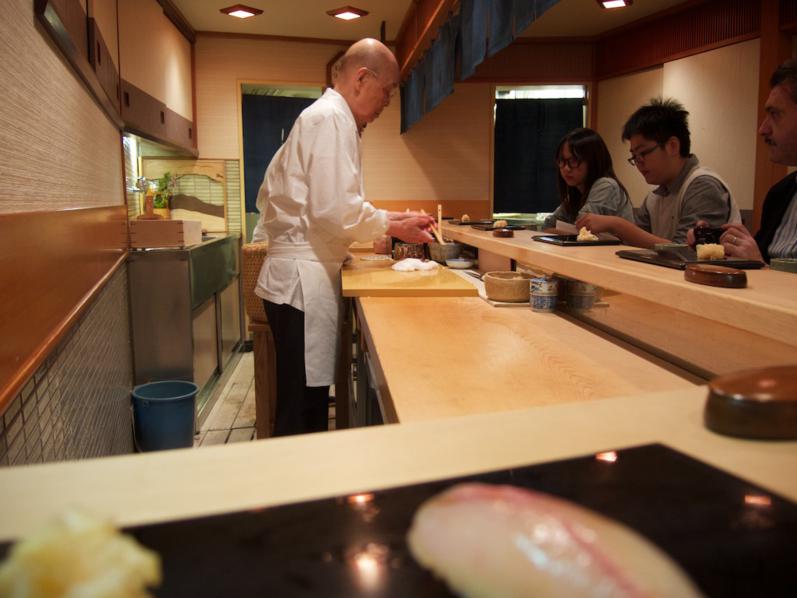
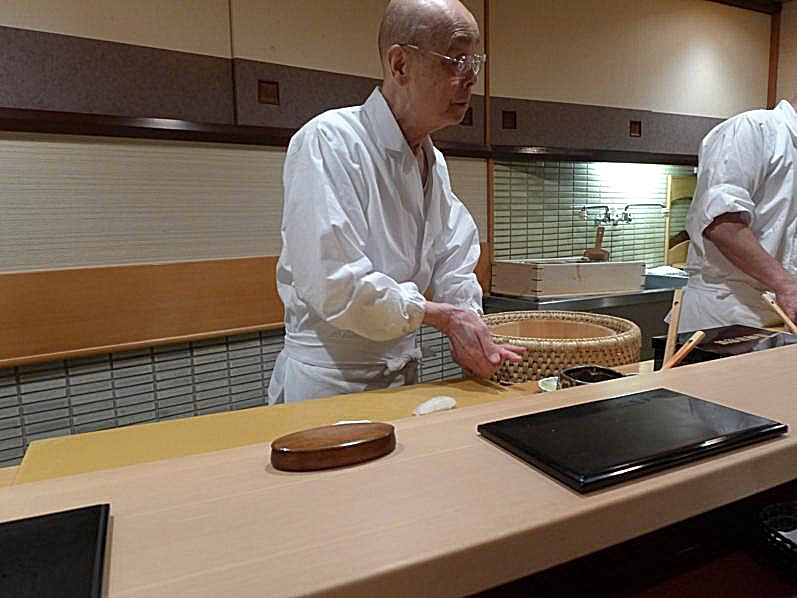
Il cammino verso la perfezione.
Concezione, esecuzione, risultato: gesti ripetuti ossessivamente nella ricerca del miglioramento continuo. Giorno dopo giorno. Per tutta una vita.
Jiro Ono è un uomo di 88 anni, ancora al posto di comando nel suo minuscolo locale nella stazione della metropolitana di Ginza.
Jiro Ono è uno shokunin: è difficile tradurre in italiano un termine così lontano dalla nostra cultura. La traduzione in “artigiano” infatti non gli rende giustizia: è molto di più.
Comporta certamente avere competenze tecniche, ma implica anche una coscienza e un atteggiamento sociale. Lo shokunin ha l’obbligo sociale di lavorare al meglio per il benessere generale della popolazione. Obbligo che è sia spirituale che materiale. Una cosa enorme, ma è fondamentale averne chiarezza prima di mettere piede qui dentro.
“Dovete innamorarvi del vostro lavoro”: così dice Jiro nel famoso documentario di David Gelb, Jiro Dreams of Sushi.
Quanto è fortunato l’uomo che riesce a trovare nel proprio lavoro passione e forza innamorandosi di quello che giornalmente è chiamato a fare per la comunità! L’unione tra vita e lavoro diventa quindi vocazione.
Tutta la vita di quest’uomo non è stato che questo: un cammino verso una perfezione che non è raggiungibile perché non si sa quale sia il suo apice ma a cui bisogna continuamente tendere.
«Io continuerò a salire, cercando di raggiungere la vetta, anche se nessuno sa quale essa sia». (Jiro Ono)
Ma Sukiyabashi Jiro non è solo il contenitore della storia di un grande uomo: qui le storie da raccontare sono molteplici e si intrecciano come si mischiano le esistenze degli esseri umani.
C’è la storia di Yoshikazu, il figlio maggiore di Jiro San: al fianco del padre tutti i giorni. E’ un macigno da portare sulla schiena quella eredità che probabilmente lo relegherà ad eterno secondo.
E’ lui che tutti i giorni va al mercato a scegliere il pesce: solo il meglio per Jiro Ono. Possono essere aperti anche 40 tonnetti prima di trovare quello degno di essere servito da Jiro San.
C’è la storia del figlio minore Takashi, che ha aperto un suo locale a Roppongi Hills che è l’esatta copia a specchio del locale del padre ( Takashi è mancino). Fuga che può diventare salvezza e rinascita.
O quella dei tanti apprendisti in attesa di un segno di approvazione dal Maestro: chi ha il compito di strizzare gli asciugamani, chi per mesi e mesi non fa altro che frittate dolci, chi ancora massaggia i polpi (non meno di cinquanta minuti per renderli morbidi).
Non ci sono concessioni, non ci sono regali: qui ogni cosa è sudata e guadagnata sul campo.
Al giorno d’oggi i genitori dicono ai figli: “Se non funziona puoi tornare a casa”. Quando i genitori dicono stupidaggini come questa, i figli sono destinati a fallire nella vita. (Jiro Ono)
Due virtù caratterizzano la cultura giapponese: l’onore e la ricerca della purezza.
L’onore è parte integrante del proprio lavoro, nell’amore che si prova per esso e nella continua ricerca del miglioramento.
La purezza va invece ricercata nella semplicità.
Niente di più semplice dell’accoppiamento di riso e pesce in un vortice armonioso che porta alla fusione di questi due elementi.
Il riso: molti tendono a cuocerlo troppo. In quello di Jiro si sente l’aceto ed è servito a temperatura corporea. È cotto ad altissima pressione, il che lo rende soffice e vaporoso, ma allo stesso tempo ogni chicco mantiene la sua forma. E’ una rivelazione, un riso straordinario.
Il pesce: niente che sia meno di eccellente. La fornitura giornaliera al mercato di Tokyo è maniacale.
L’armonia: la perfetta unione tra i due elementi si rispecchia nel gusto, unico ed emozionante.
Il wasabi, modulato in quantità a seconda del pezzo: uno schiaffo iniziale che lascia il campo al gusto di questa incredibile radice che in Giappone tocca vertici qualitativi assoluti.
Una spennellata di salsa di soia. E subito in bocca in pochi secondi, perché la perfezione è fugace.
Il menu (19 portate fisse) si sviluppa come un’onda, in un crescendo di sapori.
Solo sushi preparato dal Maestro davanti ai vostri occhi: 30 minuti per i 240 euro meglio spesi della vostra vita.
Una composizione che rende terra e cielo più vicini, continui shock neurosensoriali che non si dimenticheranno facilmente.
Chissà se avremo ancora la possibilità di gustare il sushi preparato da questo monumento della gastronomia mondiale. Chissà se lo troveremo ancora lì, a perfezionare il suo riso, il suo pesce, il suo sushi. A costruire il suo destino partendo da se stesso, giorno dopo giorno.
Dopo giorno, dopo giorno…
Note pratiche: la prenotazione può essere fatta dal concierge dell’albergo, solo il primo giorno del mese precedente la visita (esempio, il primo settembre per il mese di ottobre).
Il ristorante si trova sotto alla fermata Ginza della metropolitana: per individuarlo cercate il cartello del ristorante Birdland che riporta la scritta in inglese ed entrate nel corridoio. Jiro si trova proprio di fronte.
Il menu è fisso ma a fine pasto è possibile richiedere dei bis dei pezzi che avete preferito.
Sono accettati solo contanti, quindi ricordate di fare il pieno prima di entrare.

I cartelli da seguire per l’ingresso



Karei: passera pianuzza

Sumi-ika: Calamaro

Shima-aji: caranx vinctus (striped jack)

Akami: tonno

Chu-toro: Tonno semi grasso


Kohada: alosa americana (gizzard shad)

Mushi-awabi: abalone al vapore

Aji: sugarello (jack mackerel)

Kurumaebi: gambero bollito


Katsuo: tonnetto (bonito). Leggermente affumicato, l’apice di tutto il pasto. Gusto e consistenze indescrivibili.


Shako: canocchia

Iwashi: sardina. Altro colpo da ko, di cui infatti abbiamo chiesto il bis.


Akagai: vongola rossa (ark shell)
Uni: riccio di mare


Kobashira: cappasanta

Ikura: uova di salmone

Anago: grongo

Tamago: frittata dolce di uovo. La consistenza di questa frittata è unica. Solo una frittata? Non scherziamo…

Musk Melon: non si può descrivere l’intensità gustativa di questi costosissimi meloni giapponesi (al mercato vengono venduti intorno ai 100 euro cadauno)

Mise en place essenziale



As the kilometers of our expensive but very pleasant wander go by, we frequently happen to reflect on the feeling, of pleasure and satisfaction, that a chef experiences when he’s aware that even a single guest sitting at his table had planned, in large advance perhaps, to travel sidereal distances to go to his restaurant.
We are sure that Niko Romito experiences often this kind of feeling, being surely aware that, wherever you are, getting to the Casadonna won’t be like a piece of cake. But don’t dispirit, the culinary art of the Reale deserves much more than a simple deviation.
Before being a chef of unquestionable talent, practically an autodidact as other great ones, Romito is an intelligent person, knowledgeable and sensitive to his land. At the same time, he is a great communicator and businessman, rich of ideas that are able to nip the crisis in the bud, even in a place which is recovering from the miserable wounds of its recent past.
Romito thinks in great. He has an entrepreneurial spirit that is virtually unequaled in Italy, which he develops through various brilliant initiatives. Among these, stands out the formation school “Niko”, that in two years earned the praise of Slow Food and of the illustrious Università di Scienza Gastronomica of Pollenzo, with which an important collaboration was established. An out-match bet and afoot of other interesting projects such as “Spazio” (Space), an activity managed by the first students of the school, whom even share the revenues, a polyfunctional gourmet venue opened at Rivosondoli, in the former seat of the Reale. Its concept is to be replied in Rome and, probably, in other Italian cities.
But it’s not over yet. Soon we will also hear about “Unforketable”, in collaboration with another alimentary giant of the “Made in Italy”. A kind of encyclopedia of Italian cuisine, a project of a very high potential of which we will reveal no more.
Very many responsibilities that, anyway, don’t encumber on the creative talent of the chef from Abruzzo. He knows very well that in order to conceive a contemporary and evolved culinary art it is essential to know how to evoke the territory and, inevitably, to know inside out the foundations of the tradition.
The key of the table is the essence of the ingredients, what matters the most in a dish. Hence, sauces and dressings are reduced to the essential and leave the field to three, maximum four elements that are clearly put on focus. Their minimalist expression do not divert the commensals attention from understanding the main significance of the raw material. Behind any creation develops an obsessive research on single products of strong territorial identity, and to make the most of it they are elaborated with technical and complex steps that lead to a result of illusory simplicity. The aim is to eliminate fat, sugar and all that is unnecessary. Many try to do this, but only a few attain these indisputable results.
We definitely stand before one of the most sensitive exponents of the contemporary culinary art of our country. It would deserve, as its region, a higher visibility also abroad.
The new, minimalist and elegant dining room, is beaming during the day and warm in the evening. It is the kingdom of Cristiana, the chef’s sister, who coordinates a close-knit group of young experts of the dining room that, in perfect synergy with the kitchen, offer a friendly service of rare precision, of utterly high level.
Today the Reale is also a beautiful Relais, an example of perfect architectonic integration between antique and modern. It offers you the chance to spend some days at full round in the name of taste and relax, staying in one of Casadonna’s wonderful rooms. At your awakening, you will be welcomed by a refined breakfast and amenities that you will long remember.
The appetizers are an evergreen. Always the same ones. Always fantastic. Crostino (toasted bread) with sheep ricotta and candied cherry tomatoes, goat meatball with potatoes, croquettes of chicory and pecorino cheese, mince of sausage with candied orange, beetroot chips with rabbit liver pâté.
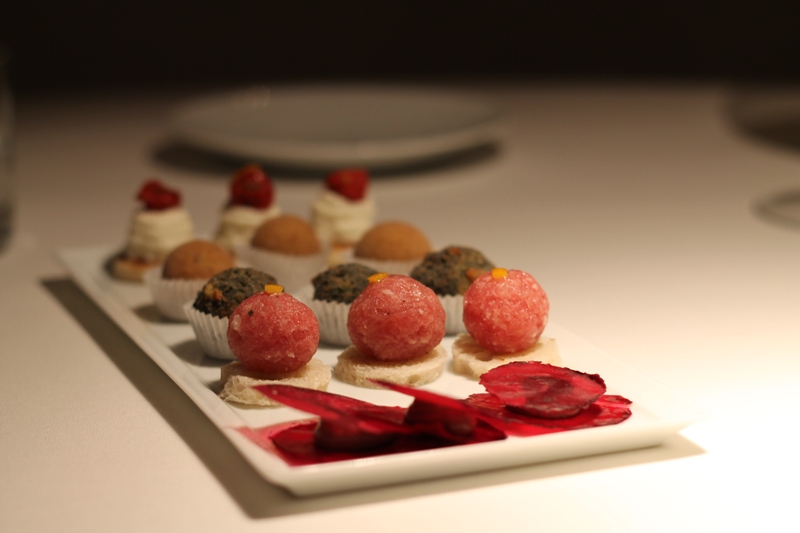
Immediately followed by the very simple and exquisite warm tart with black olives.
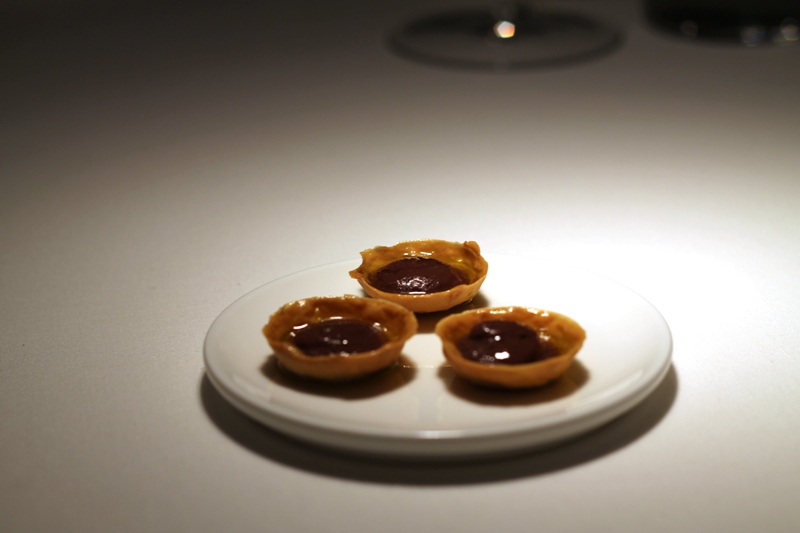
Puff pastry and breadsticks.
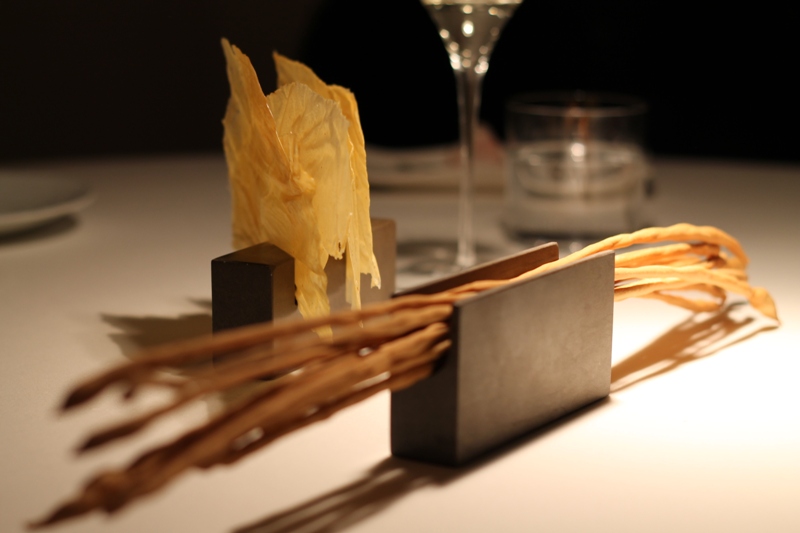
Smoked guanciale (pork jowl).
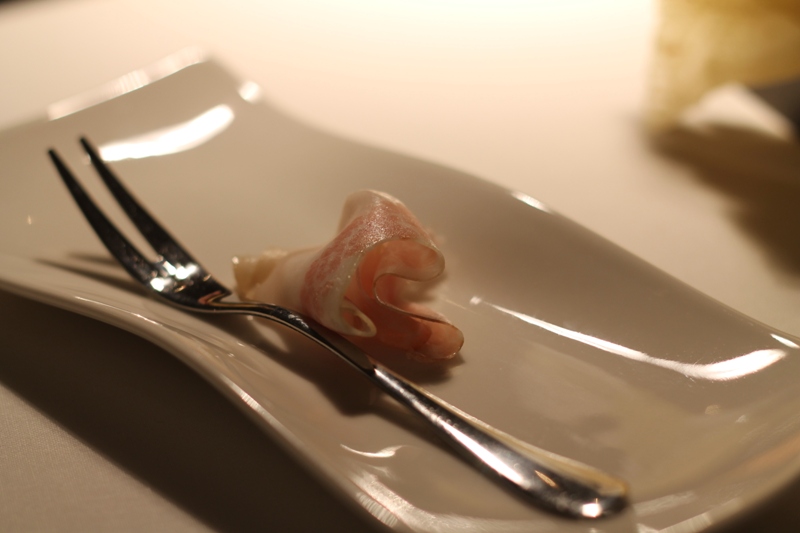
Another great mouthful of delight: fried sandwich with raw prawns, candied tomato and lettuce.
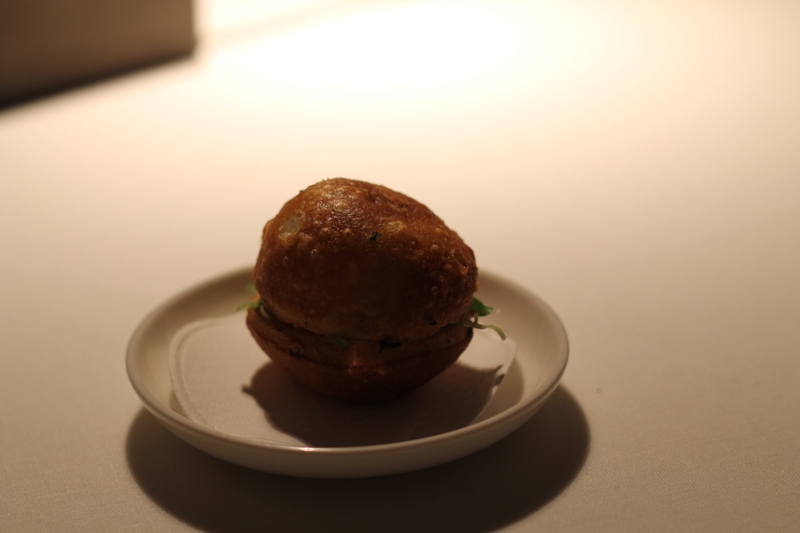
The first portion of bread.
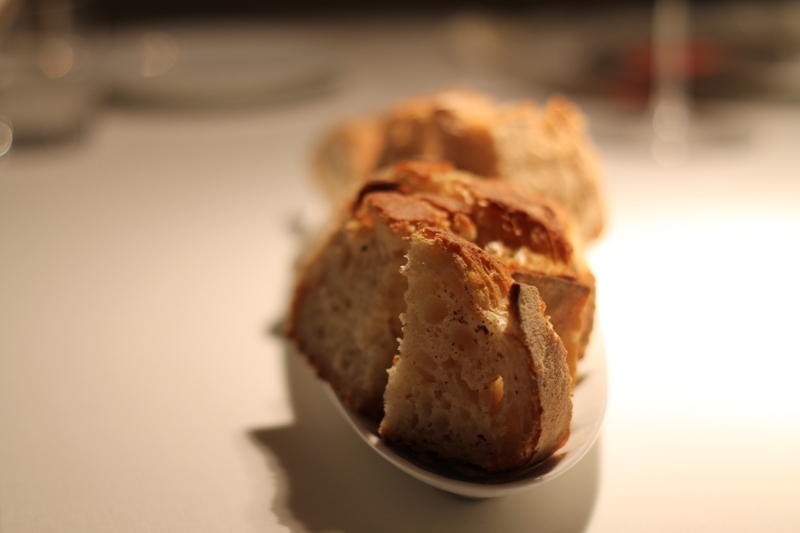
The first course is one of the novelties of this year: distilled ham, chickpeas and rosemary; the best synthesis of this the culinary art.
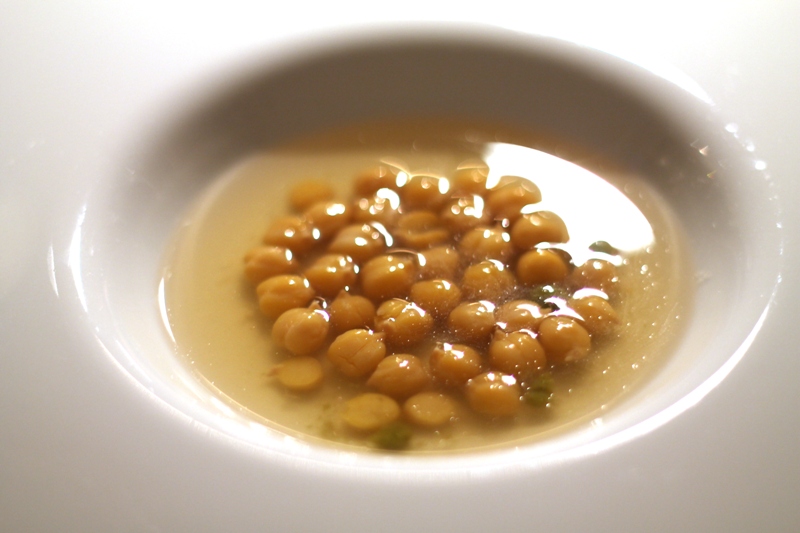
The first classic: cold emulsion of beef and oil with tarragon and raspberry mayonnaise. As soon as we’re finished, the excellent service staff replaces our wine glasses to prevent the contamination of unpleasant egg scents.

More bread, different, excellent.
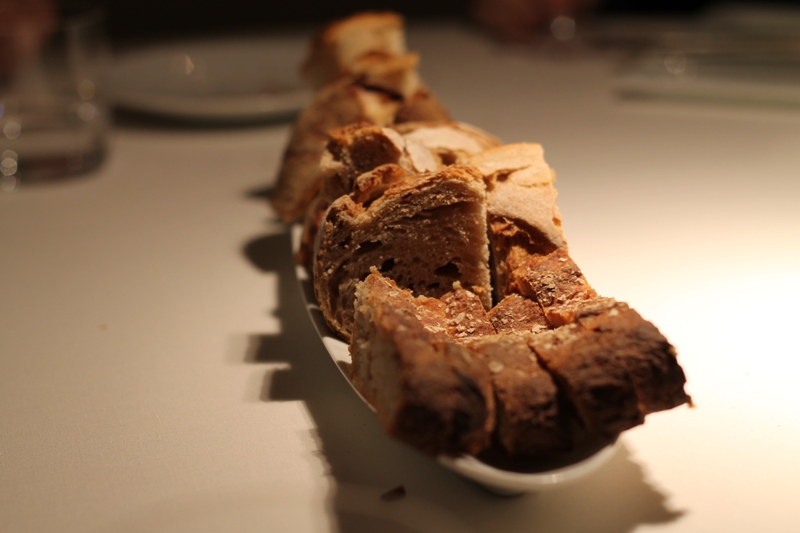
Gelatin of veal, dried porcini mushrooms, almonds, rosemary and black truffle. The introduction by Cristiana Romito is fundamental and educates the commensal to better approach the course. The truffle is not the main element and, as such, he won’t take over the other ones. It is important, here, to give the idea of a damp cold underbrush, recreated through the harmony of all ingredients combined. Technically exemplary, masterly indeed.
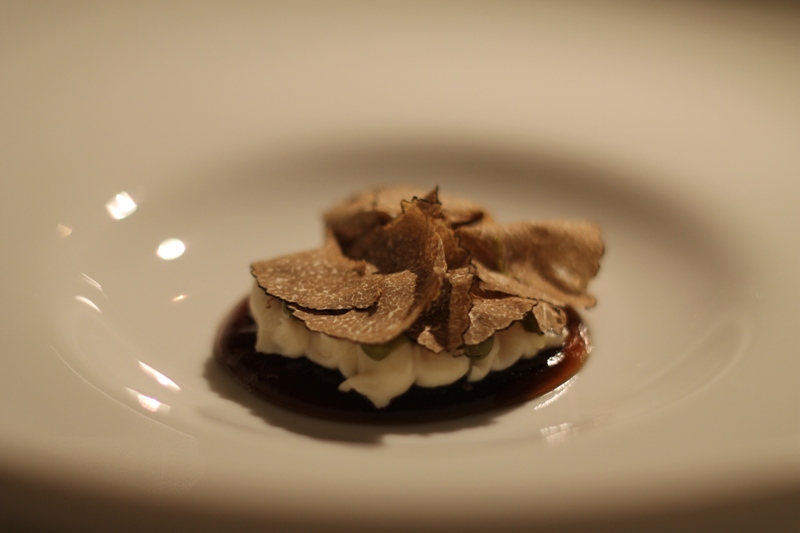
“Assoluto” a broth made of onions, parmesan cheese and toasted saffron. Probably the symbol of Reale’s culinary art. Concentration and essence of three very different ingredients, that enhance one another. It has established as a great classic of the Italian gourmet cuisine.
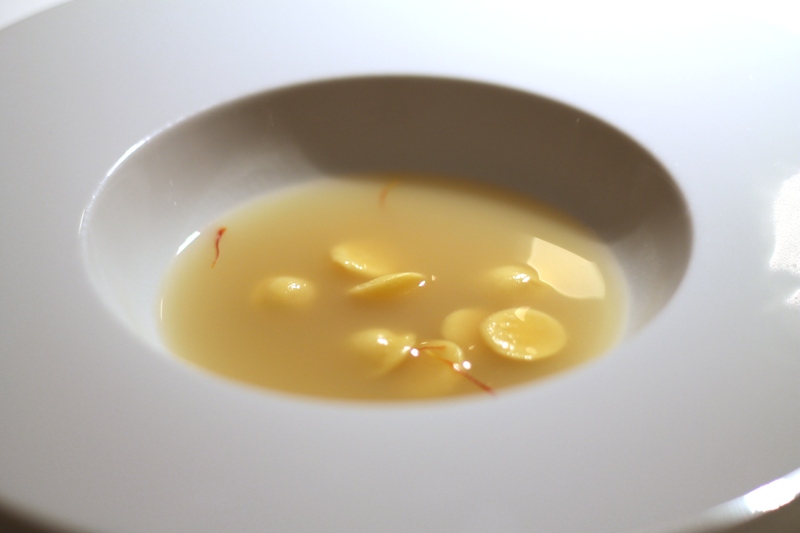
Salted codfish, potatoes, black olives and basil.
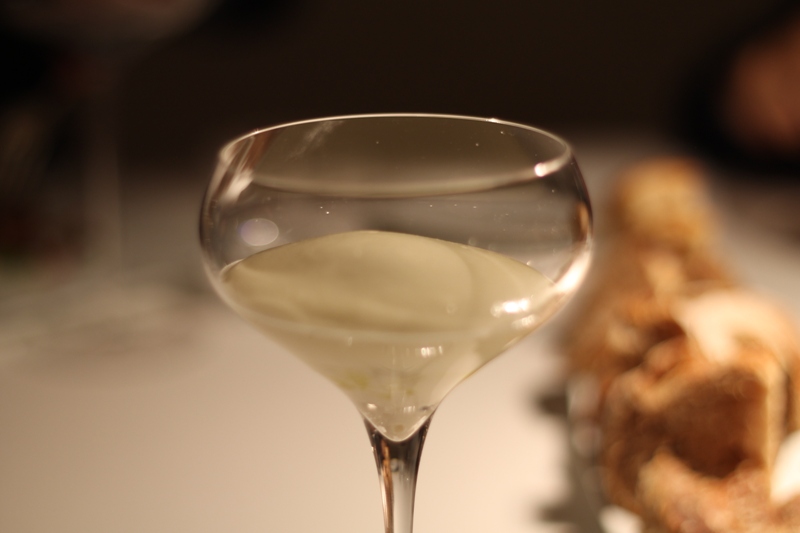
Crispy expression of tongue. A must for all lovers of the genre.
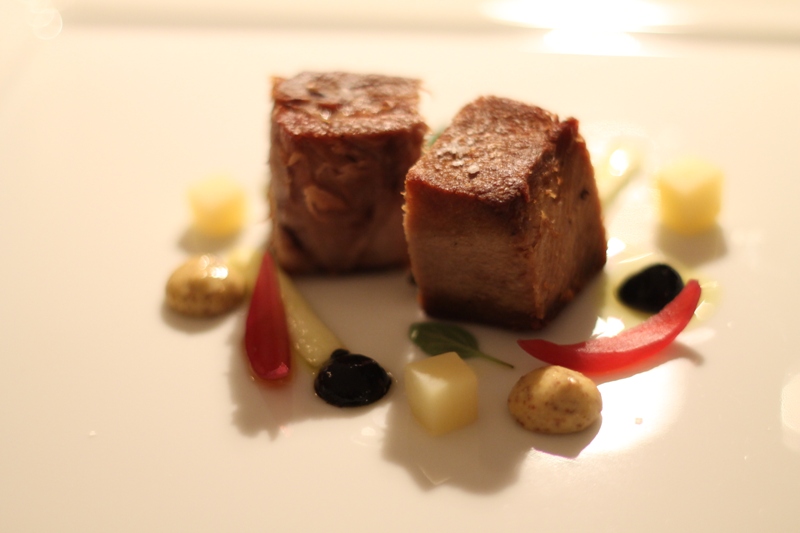
Then we’re back on the road with the first courses and another novelty: ravioli of buffalo ricotta, distilled of buffalo mozzarella, black pepper and capers. A dense broth, obtained by centrifuging the water from the buffalo mozzarella, which takes on a velvety and intriguing consistency. The sweetness of the ravioli (the dish, before its redefinition, was thought of as a dessert) is balanced by the sapid counterpoint of the capers essence. Chapeau.
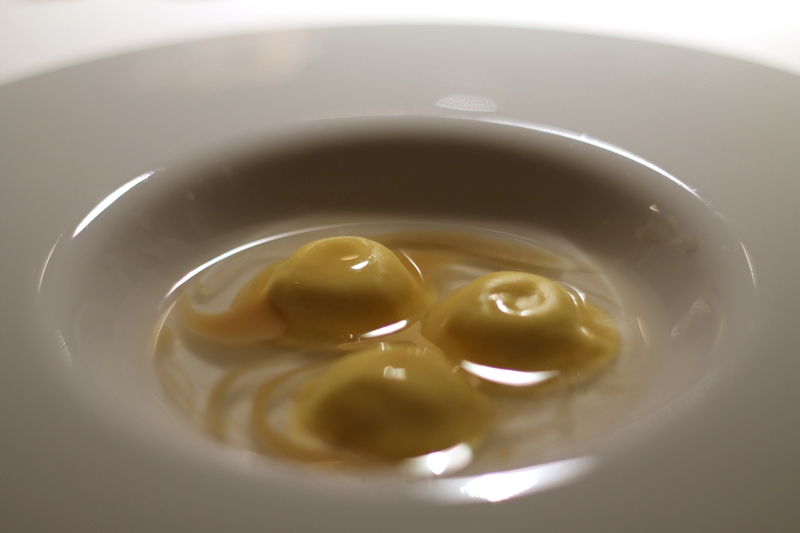
Durum wheat fettuccelle, red cherry shrimps and pink pepper. What can we say… its red color doesn’t come from tomatoes but from a concentration of shrimp heads obtained through a cold elaboration of the carapace. The fresh and sour implications that extend the iodized perception of the raw shrimp, come along with tarragon and lemon. Romito is a phenomenon regarding the first courses.
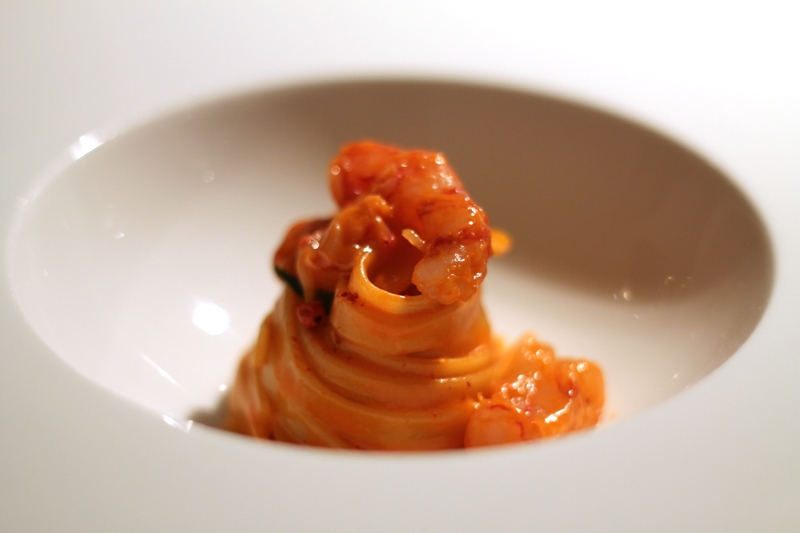
Lamb, garlic and pink grapefruit. The evolution of the territory. The meat seems raw but it is cooked in sheep milk and then smoked. We sit before the umpteenth brilliant dish.

From an extensive wine list, we drew the Montepulciano made by one of the most perceptive wine producers we have. Year 2000, the last one in the cellar. Unexpectedly not very opened up, one hour was enough to release its typical complexity and elegance.
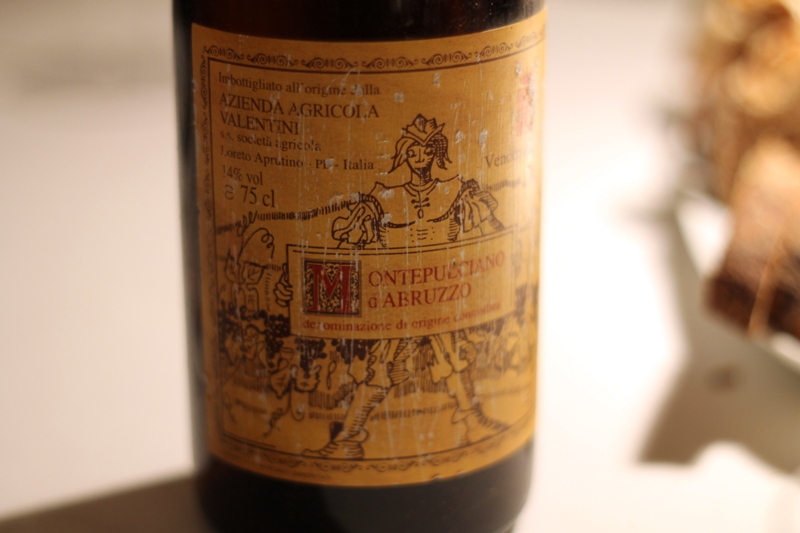
Essence. A brave dessert. The roundness of the taste, a constant feature so far, now leaves room for a cerebral delight.
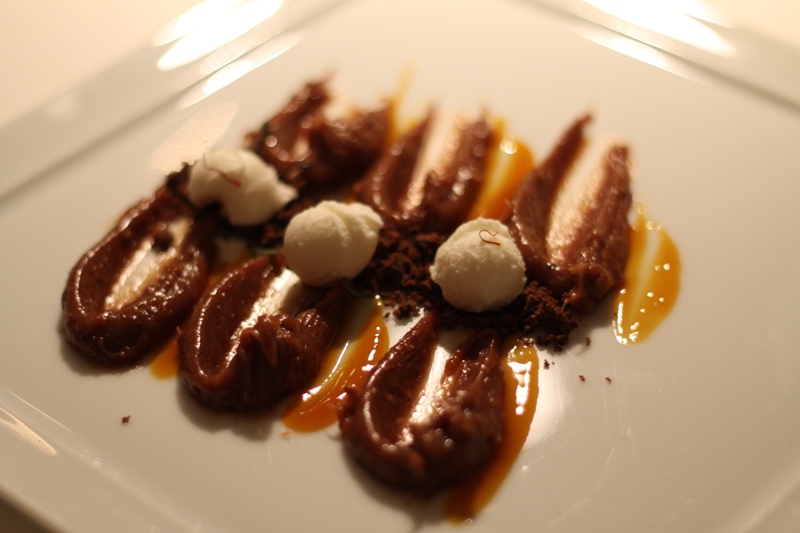
Also the small pastry is deeply thought: tart with peaches, rosemary and cream; hot chocolate bomb.
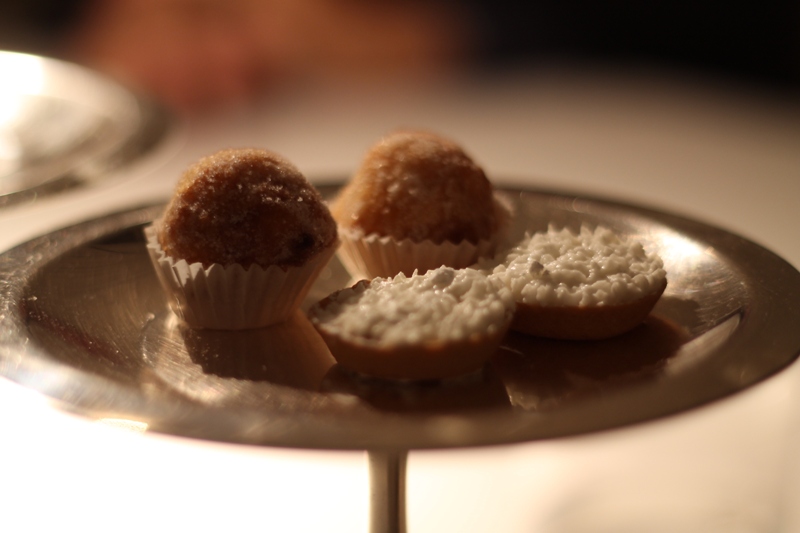
Coffee brittle and milk chocolate.
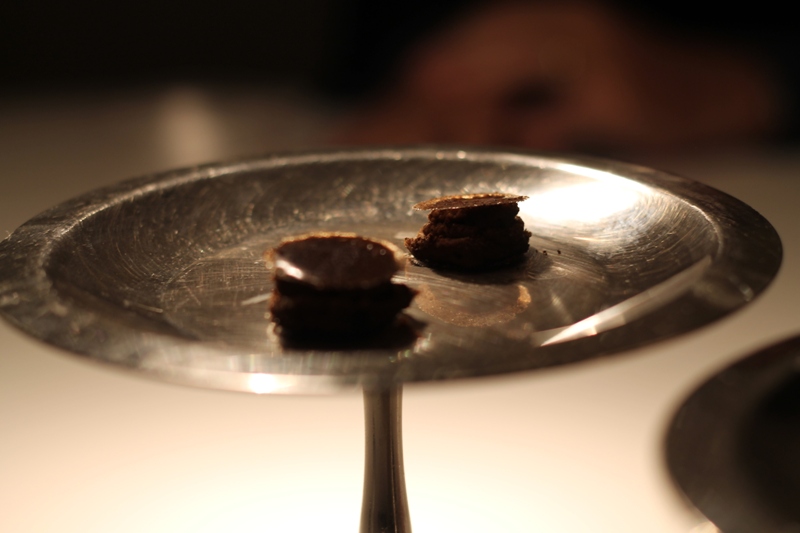
To finish, a lemon sponge.
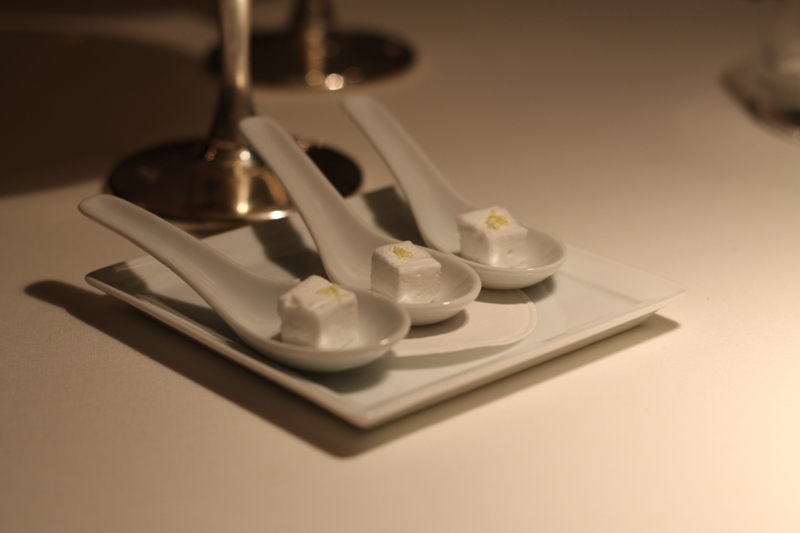
During the day the dining room is very bright.
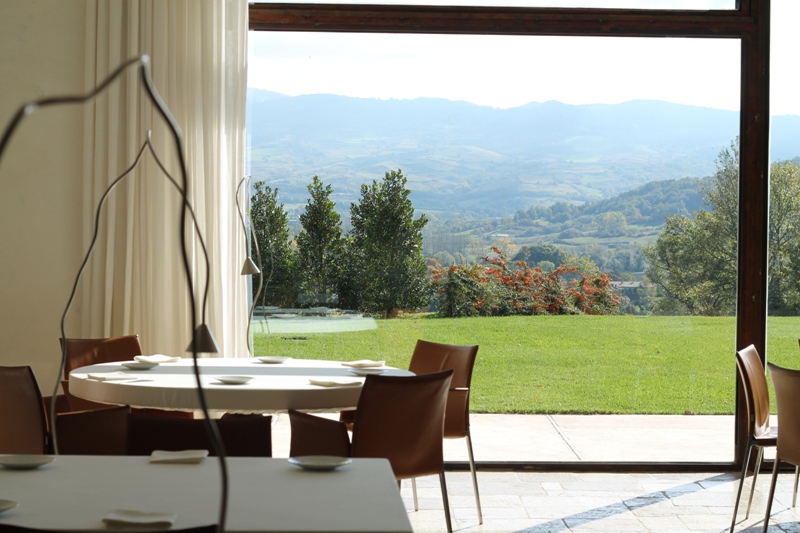
The restaurant entrance.
